Introduction to wavelets No.4
Jason反演Wavelets中文手册
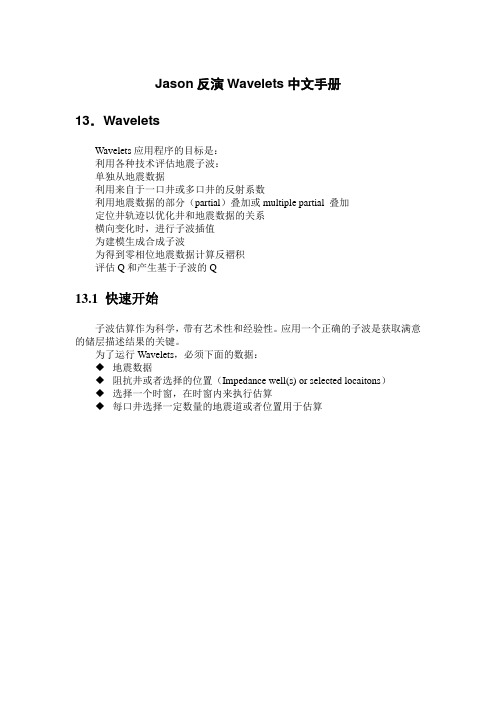
Jason反演Wavelets中文手册13.WaveletsWavelets应用程序的目标是:利用各种技术评估地震子波:单独从地震数据利用来自于一口井或多口井的反射系数利用地震数据的部分(partial)叠加或multiple partial 叠加定位井轨迹以优化井和地震数据的关系横向变化时,进行子波插值为建模生成合成子波为得到零相位地震数据计算反褶积评估Q和产生基于子波的Q13.1 快速开始子波估算作为科学,带有艺术性和经验性。
应用一个正确的子波是获取满意的储层描述结果的关键。
为了运行Wavelets,必须下面的数据:◆地震数据◆阻抗井或者选择的位置(Impedance well(s) or selected locaitons)◆选择一个时窗,在时窗内来执行估算◆每口井选择一定数量的地震道或者位置用于估算13.2 菜单导航13.2.1 File 菜单13.2.2 Input 菜单Seismic mode子波能够通过Zero-offset(ZO)地震数据和A V A非Zero-offset地震数据估算而来。
选择你喜欢工作的模式。
Preferred Types选择喜欢的查询输入测井曲线的数据类型。
对于Zero offset模式,它是P-Impedance类型。
对于A VA模式,可以是P-Sonic,S-Sonic和密度类型。
SeismicSeismic 菜单有两部分。
在第一部分中,指定了地震数据文件。
你必须提供一个包含2D或3D数据的地震数据(.mod)。
地震数据必须代表真正振幅偏移反射信息。
在Zero-offset模式中,合成地震记录是通过子波与零偏移反射系数曲线褶积而来的,其中反射系数曲线来源于输入的P-Impedance曲线。
在AV A模式中,角度依赖的反射系数来源于P-Sonic,S-Sonic和密度井曲线,所使用的角度是是在输入的A VA地震数据文件中指定的。
在第二部分中,需要设置地震数据的A V A参数。
VETS高级教师用书_Unit_4
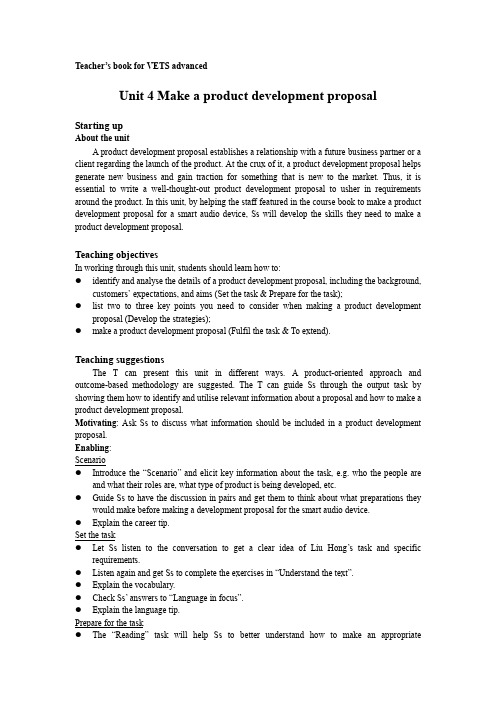
Teacher’s book for VETS advancedUnit 4 Make a product development proposalStarting upAbout the unitA product development proposal establishes a relationship with a future business partner or a client regarding the launch of the product. At the crux of it, a product development proposal helps generate new business and gain traction for something that is new to the market. Thus, it is essential to write a well-thought-out product development proposal to usher in requirements around the product. In this unit, by helping the staff featured in the course book to make a product development proposal for a smart audio device, Ss will develop the skills they need to make a product development proposal.Teaching objectivesIn working through this unit, students should learn how to:●identify and analyse the details of a product development proposal, including the background,customers’ expectations, and aim s (Set the task & Prepare for the task);●list two to three key points you need to consider when making a product developmentproposal (Develop the strategies);●make a product development proposal (Fulfil the task & To extend).Teaching suggestionsThe T can present this unit in different ways. A product-oriented approach and outcome-based methodology are suggested. The T can guide Ss through the output task by showing them how to identify and utilise relevant information about a proposal and how to make a product development proposal.Motivating: Ask Ss to discuss what information should be included in a product development proposal.Enabling:Scenario●Introduce the “Scenario” and elicit key information about the task, e.g. who the people areand what their roles are, what type of product is being developed, etc.●Guide Ss to have the discussion in pairs and get them to think about what preparations theywould make before making a development proposal for the smart audio device.●Explain the career tip.Set the task●Let Ss listen to the conversation to get a clear idea of Liu Hong’s task and specificrequirements.●Listen again and get Ss to complete the exercises in “Understand the text”.●Explain the vocabulary.●Check Ss’ answers to “Language in focus”.●Explain the language tip.Prepare for the task●The “Reading”task will help Ss to better understand how to make an appropriatedevelopment proposal for a smart audio device.●Explain the cultural tip if necessary, and ask Ss to share any possible conditions in which a company might be required to develop a new product.●In the “Listening”task, ask Ss to note down specific information about the possible improvements that could be made to a new smart audio device.●Enable Ss to develop reading and listening skills for key information by doing the“Understand the text” exercise.●Explain the vocabulary.●Check Ss’ answers to “Language in focus”.●Explain the language tip if necessary, and ask Ss to practice t he sentence pattern of “present perfect” and “present perfect progressive” with classmates.Develop the strategies●Ask Ss to discuss the purpose, structure and function of a product development proposal andhow information in the proposal should be organised.●Teach Ss how to organise information in a product development proposal by referring to thesample.●Lead Ss to read the strategy for making a product development proposal.Assessing:Fulfil the task●Encourage Ss to finish the task by explaining the steps in the course book.●Ask Ss to make their development proposal for a smart audio device.●Invite Ss to share their work with the class. Ask Ss to give feedback on each other’s work andgive your own comments or feedback.To extend●Ask Ss to do the comprehension work in Activity 1 by reading the passage.●Ask Ss to discuss the questions in Activity 2.Detailed Procedures & KeyScenarioDiscussion: Work in pairs and discuss the following question. Imagine you are Liu Hong. What preparations will you make before submitting the product development proposal?Break up the topic by asking detailed questions, such as:●Why is it important for companies to conduct research when developing new products?●What different people might be involved in developing the new product?●What factors should be considered in making a product development proposal?●What different parts might a product development proposal include?●How would you organise the different parts of the proposal in a logical order?Set the taskScriptLiu Hong: Morning, Tim. How was your trip to the Audio Expo?Tim: Well, I reaped a lot from the Expo. Before I went there, I was so confident of our products that I thought we had the best and most advanced audio products in the industry.Liu Hong: Our products do enjoy a good reputation and great popularity among the customers.Tim:I’m afraid that’s not quite the case, Hong. At the Expo, I met some of our peers, communicated with them, and tried out their products. I have to say that some of their products are much better than ours.Liu Hong:What’s so good about their products?Tim: Well, the latest audio device is enhanced with advanced technologies. Some can even make human-machine communication. Many potential customers think highly of the products.Liu Hong: Wow. That sounds competitive.Tim:Yes. So now, we need to develop our own smart audio products to take a place on the market, or we might be eliminated from the competition in the future.Liu Hong: You are right, Tim. Only through continuous innovation will we get a foothold on the market.Tim:That’s right. Now, it’s time to put our hand to the plough.Liu Hong: OK. I will discuss this with our colleagues, conduct market research and try to make a development proposal as soon as possible.V ocabulary1. At the Expo, I met some of our peers, communicated with them, and tried out their products. peer /pɪə/ n. 同行;社会地位相同的人e.g. She gets on well with her peer group.她和同龄人相处融洽。
小波分析 课程简介

小波分析课程名称:小波分析英文名称:Wavelets analysis课程编号码:070102X09适用专业:信息与计算科学课程类别:专业选修学时数:48 学分:3编写执笔人:高仕龙审定人:宋际平编写日期:2005年10月25日一、课程的性质、目的和任务本课程是信息科学的基础数学理论, 小波(wavelet)分析是一种在传统的Fourier分析的基础上发展起来的新分析方法,它由数学家和信息技术等领域的工程师各自独立发现,并共同推动而得以迅速的发展。
作为时间—频率分析方法,小波分析比Fourier分析有着许多本质性的进步,它提出了一种自适应的时域和频域同时局部化的分析方法,无论分析低频或高频的局部信号,它都能自动调节时—频窗口,以适应实际分析的需要。
在局部时—频分析中具有很强的灵活性,能聚焦到信号时段与频段的任意细节,故被誉为时—频分析的显微镜。
小波快速算法则为分析和解决实际问题带来了极大的方便。
这些特点使时—频分析的方法和应用得到了辉煌的发展。
通过本课程的学习,要求学生理解小波分析的理论,掌握小波分析的方法,并能运用到实践中去。
二、课程教学内容及教学基本要求本课程分为七讲,概括小波分析的基本概念、基本理论和基本解题方法和技巧以及实验,并讲述了小波分析在其它诸多领域的应用,要求学生会用基本的数学的软件实现小波分析的相关应用实验。
每节包括知识、例题、习题及实验四部分内容。
第一章:小波预备知识(4学时)1、教学内容线性赋范空间,巴拿赫空间,希耳伯特空间等相关实函,距离空间, 基底和框架,反演公式,线性空间,泛函知识,,傅里叶级数的复数形式,傅里叶变换的定义,傅里叶变换的性质,窗口傅里叶变换的定义,局部化特征,窗函数,时频窗的概念。
2、教学目的及要求了解线性赋范空间,巴拿赫空间,希耳伯特空间等相关实函。
理解距离空间, 基底和框架,反演公式,线性空间。
掌握泛函知识,,傅里叶级数的复数形式,傅里叶变换的定义,傅里叶变换的性质,窗口傅里叶变换的定义,局部化特征,窗函数,时频窗的概念。
《计算机辅助几何造型技术》1

计算机辅助几何造型技术主讲教师:秦开怀教授、博导qkh-dcs@所在单位:清华大学计算机科学与技术系 时间:2007年9月~2008年1月Textbooks/ReferencesJ. Hoschek& D. Lasser, Fundamentals of Computer Aided Geometric Design A K Peters Computer Aided Geometric Design, A K Peters, Ltd, Massachusetts, 1993.David F Rogers Introduction to NURBS Morgan David F Rogers,Introduction to NURBS, Morgan Kaufmann,2001.L Piegl&W Tiller The NURBS Book(2L. Piegl & W. Tiller, The NURBS Book (2nd Edition), Springer-Verlag Berlin Heidelberg, NewYork, 1997.York1997Carl deBoor, A Practical Guide to Splines, New York, Springer Verlag, 1978.York Springer-Verlag1978(Continued)M. E. Mortenson, Geometric Modeling , J h W l &S I 1985John Waley & Sons, Inc., 1985. G. Farin, Curves and Surfaces for ,Computer Aided Geometric Design (5th Edition), Elsevier Inc., 2002.(李双喜译,),,(CAGD 曲线曲面,科学出版社,2006)E J Stollnitz T DeRose &D H Salesin E. J. Stollnitz, T. DeRose & D. H. Salesin, Wavelets for Computer Graphics, Theory & Morgan Kaufmann PublishersApplications , Morgan Kaufmann Publishers, Inc., San Francisco, 1996.(Continued)Denis Zorin & Peter Schroder, Subdivision for M d li d A i ti SIGGRAPH 2000Modeling and Animation , SIGGRAPH 2000 Course Notes #23, 2000. R. Barzel, Physically-Based Modeling for Computer Graphics, A Structured Approach,Academic Press, Inc., San Diego, 1992.D. N. Metaxas, Physic-Based Deformable ,yModels, Applications to Computer Vision, Graphics & Medical Imaging , Kluwer Academicp g g ,Publishers, Massachusetts, 1997.(Continued)Donald Hearn & M.Pauline Baker, C t G hi ith O GL (Thi d Computer Graphics with OpenGL (Third Edition), Pearson Education, 2004 (中译本赫恩等著本:赫恩等著, 蔡士杰等译,《计算机图形学(第三版)》, 电子工业出版社, 200506)2005-06.) J. D. Foley, et al, Computer Graphics: y,,p pPrinciples & Practice (2nd Edition in C),Addison-Wesley, Reading, MA, 1996.y,g,,G di P li Grading PolicyThree assignments 30%Discussions/learning in classroom 5% One project substituting for the final p j g examination 65%R kRemarksThe three assignment is to be completed individually on yourself, but discussions among fellow students areyourself but discussions among fellow students areallowed.The project substitutes for the final examination Two The project substitutes for the final examination. Twostudents can work together as a group.Absolutely no sharing or copying of any code for both Absolutely no sharing or copying of any code for boththe assignments and the project! Offenders will be givena failure grade and the case will be reported to theg pdepartment.You are welcome to turn off your mobile phone before You are welcome to turn off your mobile phone beforeattending lectures.This course concentrates on seven main issues:i iNURBS curves and surfaces (including Bezier, B-spline curves and surfaces)gTriangular surfacesGordon-Coons surfacesSubdivision surfaces of arbitrary topologySubdivision surfaces of arbitrary topologyThe 2nd generation wavelets for multi-resolution modelingmodelingSolid modelingNew technology for geometric modelingContents of This Course1.Introduction2.∆Mathematic BasicsAffine mapsAffine mapsDivided differenceFunction spaceGeometric basics from curves and surfaces 3.∆Interpolatory Polynomial SplinesHermite interpolationHermite interpolationContents of This Course Contents of This Course (Continued)Quadric polynomial spline curvesCubic polynomial spline curvesSolving a linear system of equations with a g y q tridiagonal coefficient matrix Cubic parametric spline curves Cubic parametric spline curves4.*Bezier Curves and Surfaces Bezier curves defined by edge vectorsBernstein-Bezier curvesProperties of Bernstein-Bezier curves(Continued)De Casteljau algorithmDi t ti f B iDiscrete generation of Bezier curvesDegree elevation of Bezier curvesD d i f B iDegree reduction of Bezier curvesBezier spline curvesBezier interpolation curvesMatrix formula of Bezier curvesRational Bezier curvesProduct & inner product of Bezier curves Bezier surfaces(Continued)5.*B-spline Curves and SurfacesB-spline basis functions and their p ppropertiesB-spline curvesOpen curves and knot vectorsOpen curves and knot vectorsUniform B-spline curvesEndpoint interpolating B spline curves Endpoint interpolating B-spline curvesClosed B-spline curves(Continued)Chaikin algorithmDe Boor algorithmInserting knots in B-spline curves Inserting knots in B spline curvesBoehm algorithmOlso algorithmGeneral knot insertion for B-spline curvesDegree elevation of B-spline curves Degree elevation of B-spline curvesMarsden identity and recursive degree elevationPrautzsch algorithm(Continued)Arbitrarily high degree elevation for B-spline curvesDegree reduction of B-spline curvesB-spline surfacesInterpolating B-spline curves and p g p surfaces Matrix formulas of B-spline curves and Matrix formulas of B spline curves and surfaces(Continued)Matrix formula of uniform B_spline curvesMatrix formula of non-uniform B_splines Inner product of B-spline curvesGeneralized Marsden identityB-spline curve productInner product of B-spline basis functionsInner product of B-spline curves6.*NURBS Curves and SurfacesNURBS curvesNURBS curvesRepresenting conics using NURBS(Continued)Parameterization of curvesfNURBS surfacesRepresenting quadrics using NURBS surfacesfInterpolating NURBS curves and surfaces 7.Blossoming PrincipleLooking at de Casteljau algorithm from a Looking at de Casteljau algorithm from a blossoming point of viewKnot insertion from a blossoming point of Knot insertion from a blossoming point of view(Continued)Generating de Boor points based on the blossoming principleblossoming principleDegree raising of B-spline curves by blossoming8.* Triangular SurfacesBarycentric coordinatesgTriangular Bezier surfacesContinuity conditions for triangular Bezier ppatchesRational Triangular surfaces(Continued)9.*Gordon-Coons SurfacesCoons surfacesGordon-Coons surfaces on rectanglesGordon-Coons surfaces on triangles0Subd s o Su a s o b a y 10.*Subdivision Surfaces of ArbitraryTopologyCatmull-Clark surfacesCatmull-Clark surfacesDoo-Sabin surfacesContinuity of uniform subdivision surfaces Continuity of uniform subdivision surfacesNon-uniform subdivision surfaces(Continued)Convergence and continuity of non-uniform subdivision surfaces11.*The 2nd Generation Wavelets forMulti-resolution modelingMulti-resolution modelingB-spline wavelets for Multi-resolution modeling Endpoint interpolating B-spline wavelets Endpoint interpolating B-spline waveletsArbitrary Non-uniform B-spline waveletsB-spline wavelets with constraintsB spline wavelets with constraintsSubdivision-based Surface waveletsLoop Subdivision WaveletsCatmull-Clark Subdivision Wavelets√3-subdivision-based Bi-orthogonal Wavelets(Continued)12.∆Scattered Data Interpolation13.*Intersections of Curves and Surfaces14.Solid Modeling14*Solid Modeling15.Parameterization Modeling for ShapeDesign and Feature-based Modeling 16.New Technology for Geometric 16.*New Technology for GeometricModelingHierarchical B splinesHierarchical B-splinesPhysics-based modelingContents of This Course Contents of This Course (Continued)Modeling fractalized scenes (mountains,f lowers etc.)Particle system for modeling fires, clouds, water, forests etc.1.Introduction1. IntroductionSome Applications of CAGDRepresentation of large data setsVisualizing productsAutomatically producing sectionalAutomatically producing sectional drawingsModeling surfaces arising inModeling surfaces arising in construction of cars, ships & airplanesDesigning pipe systems, e.g. in chemical plants(continued)Drawing marine charts and city and relief i h maps in cartographyProduction and quality control, e.g. in q y ,g the sewing machine, textile and shoe industriesPlanning and controlling surgery Creating images in advertising television Creating images in advertising, television and film industries(continued)Constructing virtual environmentsDescribing robot paths and controlling their movementstheir movementsControlling milling machines used in manufacturingCurve modeling with constrained B-spline wavelets 保特征点的多分辨率曲线造型29曲线的多分辨率分段无缝表示30细分曲面带约束的样条曲面小波左图是采用经典B 样条曲面小波分片多分辨率表示的结果,右图是采用带约束B 的样条曲面小波分片多分辨率表示的结果,其中约束施加在接合线处。
电子信息类专业英语(西电第二版)Unit 4 Microel
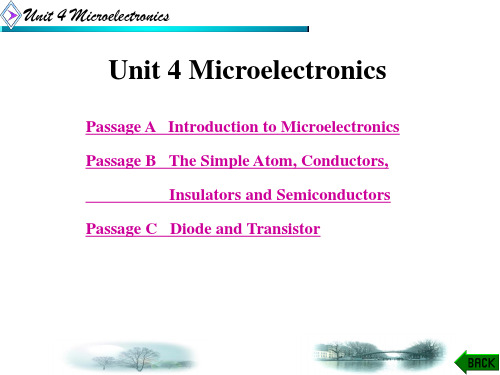
Unit 4 Microelectronics
Integrated circuits are small, light, rugged, and reliable. They require less power and lower voltages than equivalent macroscopic circuits; consequently they operate at lower temperatures, and individual components may be close together without exceeding the operating temperature limit. Relatively little stray capacitance and short time delays are produced because of the short interconnections between the individual components in IC. Maintenance is simplified because if a component of the IC fails the complete IC is usually replaced. Mass production techniques of plane technology have reduced the cost of many IC so that they are almost as inexpensive as a single transistor. Eventually most conventional circuits will be replaced by IC.
[2] The reduction in power dissipation is particularly important where a complex circuit is to be concentrated into a small space. The problem of extracting the heat generated in the circuit may then be a difficult one.
Journal of Molecular Structure THEOCHEM

Video sensor networks (VSNs) has become the recent research focus due to the rich information it provides to address various data-hungry applications. However, VSNimplementations face stringent constraints of limited communication bandwidth, processing capability, and power supply. In-network processing has been proposed as efficient means toaddress these problems. The key component of in-network processing, task mapping and scheduling problem, is investigated in this paper. Although task mapping and scheduling in wired networks of processors has been extensively studied, their application to VSNs remains largely unexplored. Existing algorithms cannot be directly implemented in VSNs due to limited resource availability and shared wireless communication medium. In this work, an application-independent task mapping and scheduling solution in multi-hop VSNs is presented that provides real-time guarantees to process video feeds. The processed data is smaller in volume which further releases the burden on the end-to-end communication. Using a novel multi-hop channel model and a communication scheduling algorithm, computation tasks and associated communication events are scheduled simultaneously with a dynamic critical-path scheduling algorithm. Dynamic voltage scaling (DVS) mechanism isimplemented to further optimize energy consumption. According to the simulation results, the proposed solution outperforms existing mechanisms in terms of guaranteeing application deadlines with minimum energy consumption.Article Outline1. Introduction2. Preliminaries2.1. Network assumptions2.2. Application and energy consumption model 2.3. Problem statement3. The proposed scheduling solution3.1. Hyper-DAG extension and multi-hop channel modeling 3.2. Communication scheduling algorithms 3.3. Scheduling with DCTMS algorithmPurchase$ 31.503.3.1. DCOS procedure 3.3.2. OSTA procedure 3.4. The DVS algorithm 4. Simulation results 4.1. Simulation parameters4.2. Simulation with a real-life application example 4.3.Simulation with randomly generated DAG 4.3.1. Effect of the application deadlines 4.3.2. Effect of the cluster size 4.3.3. Effect of the number of tasks 4.3.4. Comparison with EbTA 5. Conclusion Acknowledgements References170Evaluation of service management algorithms in adistributed web search system Original Research ArticleComputer Standards & Interfaces , Volume 29, Issue 2,February 2007, Pages 152-160Ahmed Patel, Muhammad J. KhanClose preview | Related articles | Related reference work articlesAbstract | Figures/Tables | ReferencesAbstractThe World Wide Web interconnected through the internet today offers numerous specialist topic-oriented or regional search engines and systems in a largely federated heterogeneous environment. Old ones continue to exist and new ones appear in spite of the tremendous progress achieved by their generic Web-wide rival competitors, because they produce better results in their areas of specialisation. However, finding and choosing the best specialised search engines or systems for a particular information need is difficult. This is made even more complicated by the fact that these enginesPurchase $ 31.50and systems would want to carve out a niche market that generates maximum revenue for themselves. The ADSA (Adaptive Distributed Search and Advertising) Web research project has investigated the problem at some depth and had put forward a search architecture which allows many search engines to be independently owned and controlled, offering advantages over existing centralised architectures. One aspect of the architecture has been to evaluate the service management algorithms that were designed to support competing autonomous systems in a cooperative marketplace. Here we present ADSA economic model and the service management strategies that can lead to maximum revenue generation, by making informative and intelligent decisions on search price adjustments of key quantitative parameters, as well as the results of evaluation experiments and briefly discuss the need for standardised interfaces which are required if this concept is to ease development and implementation of such a marketplace in a large scale.Article Outline1. Introduction2. ADSA economic model and pricing function2.1. The pricing function3. Evaluation3.1. Tests3.2. Performance criteria4. Experimental results5. Need for standard interfaces for administrative service management6. Conclusions and future workReferencesVitae171 Geophysical wavelet library: Applications of the continuous wavelet transform to the polarization anddispersion analysis of signals Original Research ArticleComputers & Geosciences , Volume 34, Issue 12,December 2008, Pages 1732-1752M. Kulesh, M. Holschneider, M.S. DialloClose preview | Related articles | Related reference work articlesAbstract | Figures/Tables | ReferencesAbstractIn the present paper, we consider and summarize applications of the continuous wavelet transform to 2C and 3C polarization analysis and filtering, modeling the dispersed and attenuated wave propagation in thetime –frequency domain, and estimation of the phase and group velocity and the attenuation from a seismogram. Along with a mathematical overview of each of the presented methods, we show that all these algorithms are logically combined into one software package “Geophysical Wavelet Library” developed by the authors. The novelty of this package is that we incorporate the continuous wavelet transform into the library, where the kernel is the time –frequency polarization and dispersion analysis. This library has a wide range of potential applications in the field of signal analysis and may be particularly suitable in geophysical problems that we illustrate by analyzing synthetic, geomagnetic and real seismic data.Article Outline1. Introduction2. GWL structure and implementation technology3. The CWT3.1. The direct wavelet transform 3.2. Wavelets3.3. The inverse wavelet transform 3.4. Wavelet transform of a complex signalPurchase $ 19.954. Polarization properties of two-component data and polarization filtering 4.1. Polarization analysis in the time domain 4.2. Complex trace method in the wavelet domain 4.3. Two-component polarization filter4.4. Application to the analysis of geomagnetic data5. Polarization analysis and filtering of 3C data 5.1. CWT-based polarization properties of an ellipse5.2. CWT-based polarization properties of an ellipsoid 5.3. Application to the analysis and filtering of seismic signals6. Modeling of wave propagation using a diffeomorphism in wavelet space 6.1. Linear diffeomorphism of the wavelet spectrum6.2. Describing wave dispersion and attenuation with non-linear diffeomorphism6.3. The case for non-linear frequency-dependent attenuation6.4. Modeling wave propagation in the space of polarization parameters 6.5. Parametrization of dispersion and attenuation7. An estimate of phase and group velocities and attenuation 7.1. Wavelet-based frequency –velocity analysis7.2. Inversion for the dispersion and attenuation characteristics of the medium 7.3. Application to experimental data 8. Conclusion Acknowledgements Appendix A. List of symbols References172A software framework for model predictive control with GenOpt Original Research ArticleEnergy and Buildings , Volume 42, Issue 7, July 2010, Pages 1084-1092Brian Coffey, Fariborz Haghighat, Edward Morofsky, Edward KutrowskiPurchase$ 35.95Close preview | Related articles | Related reference work articlesAbstract | Figures/Tables | ReferencesAbstractThere is a growing interest in integrated control strategies for building systems with numerous responsive elements, such as solar shading devices, thermal storage and hybrid ventilation systems, both for energy efficiency and for demand response. Model predictive control is a promising way of approaching this challenge. This paper presents a flexible software framework for model predictive control using GenOpt, along with a modified genetic algorithm developed for use within it, and applies it to a case study of demand response by zone temperature ramping in an office space. Various areas for further research and development using this framework are discussed.Article Outline1. Introduction2. Background2.1. Model predictive control in buildings research2.2. Simulation, optimization and controls software3. Framework3.1. Generic problem definition3.2. Framework overview3.3. The organizational layer3.4. Virtual testing environment4. Example algorithm4.1. Basic genetic algorithm description4.2. Using the optimization instructions file5. Example application study5.1. Demand response with zone temperature ramping5.2. Case study description 5.3. Results6.Discussion6.1. Appropriate complexity level for application studies 6.2. Improving optimization results6.3. Imperfect models, initializations and predictions6.4. Other potential research areas with SimCon7. Conclusions Acknowledgements References173Design and implementation of an environmentaldecision support systemEnvironmental Modelling & Software , Volume 16, Issue 5,July 2001, Pages 453-458W. G. Booty, D. C. L. Lam, I. W. S. Wong, P. SiconolfiClose preview | Related articles | Related reference work articlesAbstract | Figures/Tables | ReferencesAbstractAn environmental decision support system is a specific version of an environmental information system that is designed to help decision makers, managers, and advisors locate relevant information and carry out optimal solutions to problems using special tools and knowledge. The RAISON (Regional Analysis by Intelligent Systems ON microcomputers) for Windows decision support system has been developed at the National Water Research Institute, Environment Canada, over the last 10 years. It integrates data, text, maps, satellite images, pictures, video and other knowledge input. A library of software functions and tools are available for selective extraction of spatial and temporal data that can be analysed using spatial algorithms, models, statistics, expert systems, neural networks, and other information technologies. ThePurchase $ 19.95system is of a modular design which allows for flexibility in modification of the system to meet the demands of a wide range of applications. System design and practical experiences learned in the development of a decision support system for toxic chemicals in the Great Lakes of North America are discussed. Article Outline1. Introduction2. RAISON for Windows decision support system3. Great Lakes toxic chemical decision support system3.1. Databases3.1.1. Parameters3.1.2. Site_Info3.1.3. SiteDesc3.2. Modelling3.3. Neural network3.4. Expert system3.5. Optimization3.6. Data visualization4. DiscussionAcknowledgementsReferences174 DSP instrument for transient monitoring Original Research Article Computer Standards & Interfaces, Volume 33, Issue 2, February 2011, Pages 182-190Tomasz Tarasiuk, Mariusz Szweda应届生-算法工程师)|公司行业: 通信/电信运营、增值服务 计算机软件公司性质: 国企公司规模: 150-500人比比你的竞争力发布日期:2011-03-10工作地点:北京 招聘人数:2工作年限:应届毕业生 语言要求: 英语 熟练 日语 熟练学 历:硕士职位描述算法工程师招聘人数:2人工作地点:北京、上海职位描述:负责交通信息预测和海量数据分析。
文献综述-小波变换(Wavelet-Transform)的概念是1984年法国地球-...电子教案
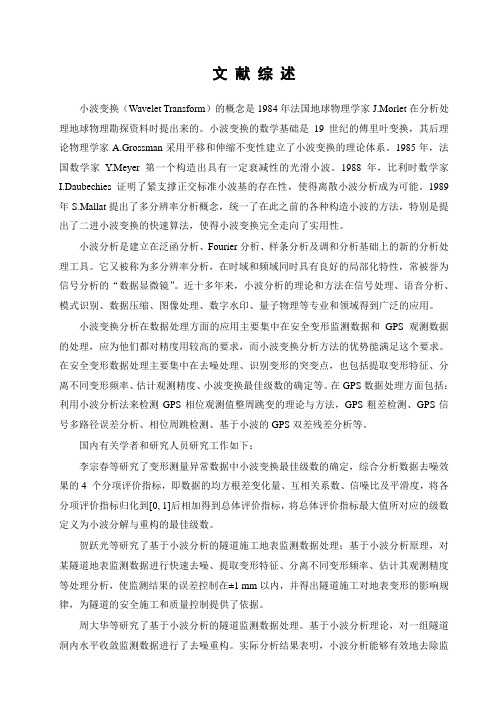
文献综述小波变换(Wavelet Transform)的概念是1984年法国地球物理学家J.Morlet在分析处理地球物理勘探资料时提出来的。
小波变换的数学基础是19世纪的傅里叶变换,其后理论物理学家A.Grossman采用平移和伸缩不变性建立了小波变换的理论体系。
1985年,法国数学家Y.Meyer第一个构造出具有一定衰减性的光滑小波。
1988年,比利时数学家I.Daubechies证明了紧支撑正交标准小波基的存在性,使得离散小波分析成为可能。
1989年S.Mallat提出了多分辨率分析概念,统一了在此之前的各种构造小波的方法,特别是提出了二进小波变换的快速算法,使得小波变换完全走向了实用性。
小波分析是建立在泛函分析、Fourier分析、样条分析及调和分析基础上的新的分析处理工具。
它又被称为多分辨率分析,在时域和频域同时具有良好的局部化特性,常被誉为信号分析的“数据显微镜”。
近十多年来,小波分析的理论和方法在信号处理、语音分析、模式识别、数据压缩、图像处理、数字水印、量子物理等专业和领域得到广泛的应用。
小波变换分析在数据处理方面的应用主要集中在安全变形监测数据和GPS观测数据的处理,应为他们都对精度用较高的要求,而小波变换分析方法的优势能满足这个要求。
在安全变形数据处理主要集中在去噪处理、识别变形的突变点,也包括提取变形特征、分离不同变形频率、估计观测精度、小波变换最佳级数的确定等。
在GPS数据处理方面包括:利用小波分析法来检测GPS相位观测值整周跳变的理论与方法,GPS粗差检测、GPS信号多路径误差分析、相位周跳检测、基于小波的GPS双差残差分析等。
国内有关学者和研究人员研究工作如下:李宗春等研究了变形测量异常数据中小波变换最佳级数的确定,综合分析数据去噪效果的4 个分项评价指标,即数据的均方根差变化量、互相关系数、信噪比及平滑度,将各分项评价指标归化到[0, 1]后相加得到总体评价指标,将总体评价指标最大值所对应的级数定义为小波分解与重构的最佳级数。
经济学经典教材推荐
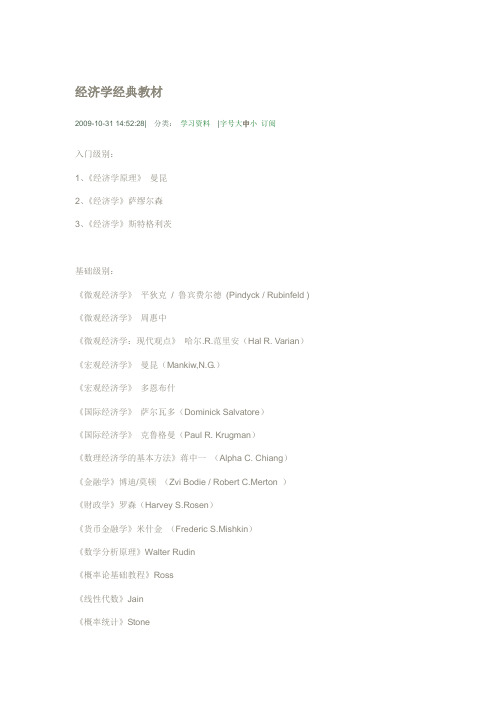
经济学经典教材2009-10-31 14:52:28| 分类:学习资料|字号大中小订阅入门级别:1、《经济学原理》曼昆2、《经济学》萨缪尔森3、《经济学》斯特格利茨基础级别:《微观经济学》平狄克/ 鲁宾费尔德(Pindyck / Rubinfeld ) 《微观经济学》周惠中《微观经济学:现代观点》哈尔.R.范里安(Hal R. Varian)《宏观经济学》曼昆(Mankiw,N.G.)《宏观经济学》多恩布什《国际经济学》萨尔瓦多(Dominick Salvatore)《国际经济学》克鲁格曼(Paul R. Krugman)《数理经济学的基本方法》蒋中一(Alpha C. Chiang)《金融学》博迪/莫顿(Zvi Bodie / Robert C.Merton )《财政学》罗森(Harvey S.Rosen)《货币金融学》米什金(Frederic S.Mishkin)《数学分析原理》Walter Rudin《概率论基础教程》Ross《线性代数》Jain《概率统计》Stone《数理金融初步》Ross提高级别:计量经济学板块:1、中文名:《计量经济学》林文夫(理论计量经济学经典教材)英文名:Econometrics by Fumio Hayashi2、中文名:《计量经济学分析》格林(应用计量经济学经典教材)英文名:Econometric Analysis by Greene3、中文名:《横截面与面板数据的计量经济学分析》伍德里奇(上面两本的补充)英文名:Econometric Analysis of Cross Section and Panel Databy Wooldridge微观经济学板块:4、中文名:《高级微观经济理论》杰里/瑞尼(高微入门教材)英文名:Advanced Microeconomic Theoryby Geoffrey A. Jehle / Philip J. Reny5、中文名:《微观经济学高级教程》范里安(高微基础教材)英文名:Microeconomics Analysis by Hal R. Varian6、中文名:《微观经济学》安德鲁.马斯-科莱尔等(哈佛教材,高微最顶尖教材)英文名:Microeconomic Theoryby Andreu Mas-Colell Michael D. Whinston Jerry R.Green (MWG)宏观经济学板块:7、中文名:《高级宏观经济学》戴维.罗默(高宏入门教材)英文名:Advanced Macroeconomics by David Romer8、中文名:《动态宏观经济理论》萨金特(高宏基础教材)英文名:Recursive Macroeconomic Theoryby Lars Ljungqvist Thomas I. Sargent9、中文名:《经济动态的递归方法》卢卡斯(高宏最顶尖教材)英文名:recursive method in economics dynamics by Robert E. Lucas博弈论板块:10、中文名:《博弈论教程》马丁.J.奥斯本阿里尔·鲁宾斯坦(博弈论入门)英文名:An Introduction to Game Theoryby Martin J.Osborne Ariel Rubinstein11、中文名:《博弈论基础》吉本斯(博弈论基础)英文名:A Primer in Game Theory by Roerbt Gibbons12、中文名:《博弈论》朱·弗登博格让·梯若尔(博弈论最顶尖教材)英文名:Game Theory by Drew Fudenberg Jean Tirole补充级别:1、《经济学中的分析方法》Akira Takayama2、《货币理论与政策》Carl E. Walsh3、《时间序列分析》汉密尔顿4、《高等微积分》Lynn H.Loomis / Shlomo Stermberg (哈佛教材)5、《分析学》Elliott H. Lieb / Michael Loss6、《拓扑学》James R.Munkres7、《金融数学》Stampfli8、《复分析》Ahlfors9、《泛函分析》Rudin10、《实分析与复分析》Rudin11、《时间序列的小波方法》Percival12、《数理统计与数据分析》Rice13、《随机过程导论》Kao14、《应用回归分析和其他多元方法》Kleinbaum15、《预测与时间序列》Bowerman16、《多元数据分析》Lattin17、《微分方程与边界值问题》Zill18、《数学建模》Giordano19、《离散数学及其应用》Rosen20、《组合数学教程》Van Lint21、《逼近论教程》Cheney22、《概率论及其在投资、保险、工程中的应用》Bean入门阶段:中文版名称:《经济学原理》曼昆英文版名称:principle of economics by Mankiw,N.G. 基础阶段:《微观经济学》周惠中《微观经济学:现代观点》哈尔.R.范里安(Hal R. Varian)《宏观经济学》曼昆(Mankiw,N.G.)《宏观经济学》多恩布什(Rudiger Dornbusch / Stanley Fischer / Richard Startz)《国际经济学》萨尔瓦多(Dominick Salvatore)《国际经济学》克鲁格曼(Paul R. Krugman)《全球视角的宏观经济学》萨克斯(Jeffrey D. Sachs)《数理经济学的基本方法》蒋中一(Alpha C. Chiang)《金融学》博迪/莫顿(Zvi Bodie / Robert C.Merton)《财政学》罗森(Harvey S.Rosen)《货币金融学》米什金(Frederic S.Mis hkin)《货币理论与政策》Carl E. Walsh《经济学中的分析方法》高山晟(Akira Takayama)《金融经济学原理》LeRoy / Werner提高阶段:①计量经济学:⑴中文名:《计量经济学》林文夫(理论计量经济学经典教材)英文名:Econometrics by Fumio Hayashi⑵中文名:《计量经济学分析》格林(应用计量经济学经典教材)英文名:Econometric Analysis by Greene⑶中文名:《横截面与面板数据的经济计量分析》伍德里奇英文名:Econometric Analysis of Cross Section and Panel Data by Wooldridge②微观经济学:⑴中文名:《高级微观经济理论》杰里/瑞尼(JR)英文名:Advanced Microeconomic Theory by Geoffrey A. Jehle /Philip J. Reny简称(JR)⑵中文名:《微观经济学高级教程》范里安英文名:Microeconomics Analysis by Hal R. Varian⑶中文名:《微观经济学》安德鲁.马斯-科莱尔等(MWG)英文名:Microeconomic Theory by Andreu Mas-Colell /Michael D. Whinston / Jerry R.Green简称(MWG)③宏观经济学:⑴中文名:《高级宏观经济学》戴维.罗默英文名:Advanced Macroeconomics by David Romer⑵中文名:《动态宏观经济理论》萨金特英文名:Dynamic Macroeconomic Theory by Thomas J. Sargent⑶中文名:《经济动态的递归方法》卢卡斯英文名:Recursive method in economics dynamics by RobertE. Lucas④博弈论:⑴中文名:《博弈论基础》吉本斯英文名:A Primer in Game Theory by Robert Gibbons⑵中文名:《博弈论教程》奥斯本英文名:A Course in Game Theory by Martin J.Osborne / Ariel Rubinstein⑶中文名:《博弈论》梯若尔英文名:Game Theory by Drew Fudenberg / Jean Tirole经济学PHD学习经验《Principle of Mathematical Analysis》(Baby Rudin)张筑生老师的《数学分析新讲》已经非常好了但在难度上仍跟不及《Baby Rudin》。
美国金融学专业必读教材
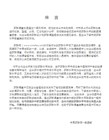
美国金融学专业必读教材去美国读金融研究生推荐看的书:1. Real Analysis(实分析)Calculus/ Michael Spivak2. Ordinary Differential Equations(常微分方程)Ordinary Differential Equations With Applications/ Larry C. Andrews本书涵盖了几乎所有基本的常微分知识:一阶、二阶、拉普拉斯变换、方程系统等。
更为可贵的是,有两个章节详细介绍了ODE 在物理中的应用,这对Finance的学习会大有裨益,毕竟Finance和Physics有千丝万缕的联系。
3. Partial Differential Equations(偏微分方程)Partial Differential Equations for Scientists & Engineers/ S. J. Farlow4. Numerical Analysis(数值分析)Numerical Analysis/ Burden, Faires/ 8th Edition5. Intro to Topology(拓扑学引论)Topology:A First Class/ James R. MunkresIntroduction to Topology and Mordern Analysis/ George Simmons6. Applied Linear Algebra(线代)Numerical Linear Algebra/ Lloyd N. Trefethen, David Bau, III.Matrix Computations/Golub and Van Loan.7. Probability & Statistics (概率与统计)Mathematical Statistics with Applications/ Dennis Wackerly, William Mendenhall, Richard L. Scheaffer.Statistical Inference/ George Casella, Roger Berger8. Complex Variables(复变函数)9. Wavelet(小波分析)Introduction to Wavelets and Wavelets Transforms/ Sidney Burrus, Ramesh GopinathAn introduction to Wavelets/ David WalnutAn introcution to Wavelets and other Filtering Method in Finance and Economics/ Ramazan Gencay需要提醒的是,这些原版的书不容易在国内买到,但是,有志向去美国读金融或经济的同学可以选择内容相近的中文书进行学习,毕竟一个扎实的数学功底能够使将来的美国金融专业的学习更有收获。
国 外 大 学 部 分 现 用 教 材 及 教 学 参 考 书
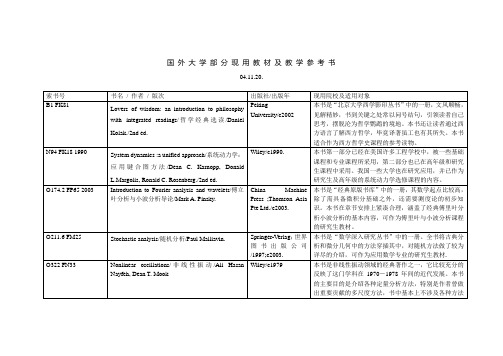
Multimedia video-based surveillance systems :requirements, issues,and solutions/基于视频的多媒体监视系统需求、问题及其解答/edited by Gian Luca Foresti, Petri Men, Carlo S.Regazzoni.
O174.2 FP65 2003
Introduction to Fourier analysis and wavelets/傅立叶分析与小波分析导论/Mark A. Pinsky.
China Machine Press ;Thomson Asia Pte Ltd./c2003.
本书是“经典原版书库”中的一册,其数学起点比较高,除了需具备微积分基础之外,还需要测度论的初步知识。本书在章节安排上紧凑合理,涵盖了经典傅里叶分析小波分析的基本内容,可作为傅里叶与小波分析课程的研究生教材。
TQ174.1 FG79
An introduction to the mechanical properties of ceramics/陶瓷材料力学性能导论/David J.Green
Cambridge University Press/c1998
本书全面介绍了陶瓷材料的力学性能以及这些力学性能与结构之间的关系,已由清华大学材料系龚江宏副教授译为中文。这是国内第一本专门介绍陶瓷材料力学性能的译著,可作为研究生和高年级本科生的教材。
System dynamics :a unified approach/系统动力学:应用键合图方法/Dean C. Karnopp, Donald L.Margolis, Ronald C. Rosenberg./2nd ed.
INTERNATIONAL JOURNAL OF CIRCUIT THEORY AND APPLICATIONS
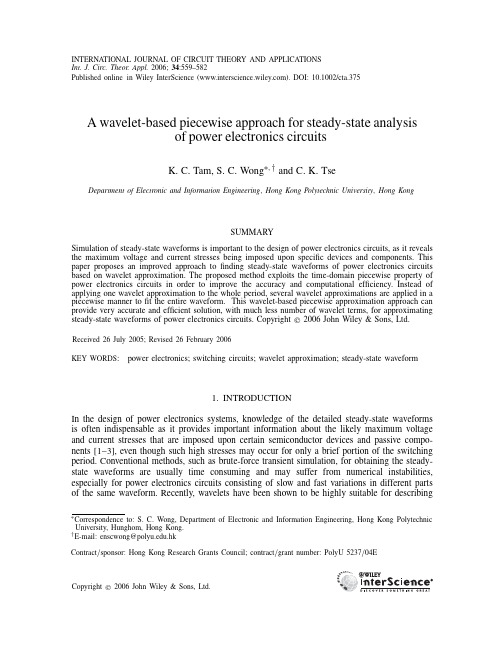
INTERNATIONAL JOURNAL OF CIRCUIT THEORY AND APPLICATIONSInt.J.Circ.Theor.Appl.2006;34:559–582Published online in Wiley InterScience().DOI:10.1002/cta.375A wavelet-based piecewise approach for steady-state analysisof power electronics circuitsK.C.Tam,S.C.Wong∗,†and C.K.TseDepartment of Electronic and Information Engineering,Hong Kong Polytechnic University,Hong KongSUMMARYSimulation of steady-state waveforms is important to the design of power electronics circuits,as it reveals the maximum voltage and current stresses being imposed upon specific devices and components.This paper proposes an improved approach tofinding steady-state waveforms of power electronics circuits based on wavelet approximation.The proposed method exploits the time-domain piecewise property of power electronics circuits in order to improve the accuracy and computational efficiency.Instead of applying one wavelet approximation to the whole period,several wavelet approximations are applied in a piecewise manner tofit the entire waveform.This wavelet-based piecewise approximation approach can provide very accurate and efficient solution,with much less number of wavelet terms,for approximating steady-state waveforms of power electronics circuits.Copyright2006John Wiley&Sons,Ltd.Received26July2005;Revised26February2006KEY WORDS:power electronics;switching circuits;wavelet approximation;steady-state waveform1.INTRODUCTIONIn the design of power electronics systems,knowledge of the detailed steady-state waveforms is often indispensable as it provides important information about the likely maximum voltage and current stresses that are imposed upon certain semiconductor devices and passive compo-nents[1–3],even though such high stresses may occur for only a brief portion of the switching period.Conventional methods,such as brute-force transient simulation,for obtaining the steady-state waveforms are usually time consuming and may suffer from numerical instabilities, especially for power electronics circuits consisting of slow and fast variations in different parts of the same waveform.Recently,wavelets have been shown to be highly suitable for describingCorrespondence to:S.C.Wong,Department of Electronic and Information Engineering,Hong Kong Polytechnic University,Hunghom,Hong Kong.†E-mail:enscwong@.hkContract/sponsor:Hong Kong Research Grants Council;contract/grant number:PolyU5237/04ECopyright2006John Wiley&Sons,Ltd.560K.C.TAM,S.C.WONG AND C.K.TSEwaveforms with fast changing edges embedded in slowly varying backgrounds[4,5].Liu et al.[6] demonstrated a systematic algorithm for approximating steady-state waveforms arising from power electronics circuits using Chebyshev-polynomial wavelets.Moreover,power electronics circuits are piecewise varying in the time domain.Thus,approx-imating a waveform with one wavelet approximation(ing one set of wavelet functions and hence one set of wavelet coefficients)is rather inefficient as it may require an unnecessarily large wavelet set.In this paper,we propose a piecewise approach to solving the problem,using as many wavelet approximations as the number of switch states.The method yields an accurate steady-state waveform descriptions with much less number of wavelet terms.The paper is organized as follows.Section2reviews the systematic(standard)algorithm for approximating steady-state waveforms using polynomial wavelets,which was proposed by Liu et al.[6].Section3describes the procedure and formulation for approximating steady-state waveforms of piecewise switched systems.In Section4,application examples are presented to evaluate and compare the effectiveness of the proposed piecewise wavelet approximation with that of the standard wavelet approximation.Finally,we give the conclusion in Section5.2.REVIEW OF WA VELET APPROXIMATIONIt has been shown that wavelet approximation is effective for approximating steady-state waveforms of power electronics circuits as it takes advantage of the inherent nature of wavelets in describing fast edges which have been embedded in slowly moving backgrounds[6].Typically,power electronics circuits can be represented by a time-varying state-space equation˙x=A(t)x+U(t)(1) where x is the m-dim state vector,A(t)is an m×m time-varying matrix,and U is the inputfunction.Specifically,we writeA(t)=⎡⎢⎢⎢⎣a11(t)a12(t)···a1m(t)............a m1(t)a m2(t)···a mm(t)⎤⎥⎥⎥⎦(2)andU(t)=⎡⎢⎢⎢⎣u1(t)...u m(t)⎤⎥⎥⎥⎦(3)In the steady state,the solution satisfiesx(t)=x(t+T)for0 t T(4) where T is the period.For an appropriate translation and scaling,the boundary condition can be mapped to the closed interval[−1,1]x(+1)=x(−1)(5) Copyright2006John Wiley&Sons,Ltd.Int.J.Circ.Theor.Appl.2006;34:559–582A WA VELET-BASED PIECEWISE APPROACH FOR STEADY-STATE ANALYSIS561 Assume that the basic time-invariant approximation equation isx i(t)=K T i W(t)for−1 t 1and i=1,2,...,m(6) where W(t)is any wavelet basis of size2n+1+1(n being the wavelet level),K T i=[k i,0,...,k i,2n+1] is a coefficient vector of dimension2n+1+1,which is to be found.‡The wavelet transformedequation of(1)isKD W=A(t)K W+U(t)(7)whereK=⎡⎢⎢⎢⎢⎢⎢⎢⎣k1,0k1,1···k1,2n+1k2,0k2,1···k2,2n+1............k m,0k m,1···k m,2n+1⎤⎥⎥⎥⎥⎥⎥⎥⎦(8)Thus,(7)can be written generally asF(t)K=−U(t)(9) where F(t)is a m×(2n+1+1)m matrix and K is a(2n+1+1)m-dim vector,given byF(t)=⎡⎢⎢⎢⎢⎢⎢⎢⎢⎢⎢⎢⎣a11(t)W T(t)−W T(t)D T···a1i(t)W T(t)···a1m W T(t)...............a i1(t)W T(t)···a ii(t)W T(t)−W T(t)D T···a im W T(t)...............a m1(t)W T(t)···a mi(t)W T(t)···a mm W T(t)−W T(t)D T⎤⎥⎥⎥⎥⎥⎥⎥⎥⎥⎥⎥⎦(10)K=[K T1···K T m]T(11)Note that since the unknown K is of dimension(2n+1+1)m,we need(2n+1+1)m equations. Now,the boundary condition(5)provides m equations,i.e.[W(+1)−W(−1)]T K i=0for i=1,...,m(12) This equation can be easily solved by applying an appropriate interpolation technique or via direct numerical convolution[11].Liu et al.[6]suggested that the remaining2n+1m equations‡The construction of wavelet basis has been discussed in detail in Reference[6]and more formally in Reference[7].For more details on polynomial wavelets,see References[8–10].Copyright2006John Wiley&Sons,Ltd.Int.J.Circ.Theor.Appl.2006;34:559–582562K.C.TAM,S.C.WONG AND C.K.TSEare obtained by interpolating at2n+1distinct points, i,in the closed interval[−1,1],and the interpolation points can be chosen arbitrarily.Then,the approximation equation can be written as˜FK=˜U(13)where˜F= ˜F1˜F2and˜U=˜U1˜U2(14)with˜F1,˜F2,˜U1and˜U2given by˜F1=⎡⎢⎢⎢⎢⎢⎢⎢⎢⎢⎢⎢⎢⎢⎢⎣[W(+1)−W(−1)]T(00···0)···(00···0)(00···0)[W(+1)−W(−1)]T···(00···0)............(00···0)2n+1+1columns(00···0)···[W(+1)−W(−1)]T(2n+1+1)m columns⎤⎥⎥⎥⎥⎥⎥⎥⎥⎥⎥⎥⎥⎥⎥⎦⎫⎪⎪⎪⎪⎪⎪⎪⎪⎪⎪⎪⎪⎪⎪⎬⎪⎪⎪⎪⎪⎪⎪⎪⎪⎪⎪⎪⎪⎪⎭m rows(15)˜F2=⎡⎢⎢⎢⎢⎢⎢⎢⎢⎣F( 1)F( 2)...F( 2n+1)(2n+1+1)m columns⎤⎥⎥⎥⎥⎥⎥⎥⎥⎦⎫⎪⎪⎪⎪⎪⎪⎪⎪⎬⎪⎪⎪⎪⎪⎪⎪⎪⎭2n+1m rows(16)˜U1=⎡⎢⎢⎢⎣...⎤⎥⎥⎥⎦⎫⎪⎪⎪⎬⎪⎪⎪⎭m elements(17)˜U2=⎡⎢⎢⎢⎢⎢⎣−U( 1)−U( 2)...−U( 2n+1)⎤⎥⎥⎥⎥⎥⎦⎫⎪⎪⎪⎪⎪⎬⎪⎪⎪⎪⎪⎭2n+1m elements(18)Finally,by solving(13),we obtain all the coefficients necessary for generating an approximate solution for the steady-state system.Copyright2006John Wiley&Sons,Ltd.Int.J.Circ.Theor.Appl.2006;34:559–582A WA VELET-BASED PIECEWISE APPROACH FOR STEADY-STATE ANALYSIS5633.WA VELET-BASED PIECEWISE APPROXIMATION METHODAlthough the above standard algorithm,given in Reference[6],provides a well approximated steady-state solution,it does not exploit the piecewise switched nature of power electronics circuits to ease computation and to improve accuracy.Power electronics circuits are defined by a set of linear differential equations governing the dynamics for different intervals of time corresponding to different switch states.In the following,we propose a wavelet approximation algorithm specifically for treating power electronics circuits.For each interval(switch state),we canfind a wavelet representation.Then,a set of wavelet representations for all switch states can be‘glued’together to give a complete steady-state waveform.Formally,consider a p-switch-state converter.We can write the describing differential equation, for switch state j,as˙x j=A j x+U j for j=1,2,...,p(19) where A j is a time invariant matrix at state j.Equation(19)is the piecewise state equation of the system.In the steady state,the solution satisfies the following boundary conditions:x j−1(T j−1)=x j(0)for j=2,3,...,p(20) andx1(0)=x p(T p)(21)where T j is the time duration of state j and pj=1T j=T.Thus,mapping all switch states to the close interval[−1,1]in the wavelet space,the basic approximate equation becomesx j,i(t)=K T j,i W(t)for−1 t 1(22) with j=1,2,...,p and i=1,2,...,m,where K T j,i=[k1,i,0···k1,i,2n+1,k2,i,0···k2,i,2n+1,k j,i,0···k j,i,2n+1]is a coefficient vector of dimension(2n+1+1)×p,which is to be found.Asmentioned previously,the state equation is transformed to the wavelet space and then solved by using interpolation.The approximation equation is˜F(t)K=−˜U(t)(23) where˜F=⎡⎢⎢⎢⎢⎢⎢⎢⎢⎢⎢⎣˜F˜F1˜F2...˜Fp⎤⎥⎥⎥⎥⎥⎥⎥⎥⎥⎥⎦and˜U=⎡⎢⎢⎢⎢⎢⎢⎢⎢⎢⎢⎣˜U˜U1˜U2...˜Up⎤⎥⎥⎥⎥⎥⎥⎥⎥⎥⎥⎦(24)Copyright2006John Wiley&Sons,Ltd.Int.J.Circ.Theor.Appl.2006;34:559–582564K.C.TAM,S.C.WONG AND C.K.TSEwith ˜F0,˜F 1,˜F 2,˜F p ,˜U 0,˜U 1,˜U 2and ˜U p given by ˜F 0=⎡⎢⎢⎢⎢⎢⎢⎢⎢⎢⎢⎢⎢⎢⎢⎣F a 00···F b F b F a 0···00F b F a ···0...............00···F b F a (2n +1+1)×m ×p columns⎤⎥⎥⎥⎥⎥⎥⎥⎥⎥⎥⎥⎥⎥⎥⎦⎫⎪⎪⎪⎪⎪⎪⎪⎪⎪⎪⎪⎪⎪⎪⎬⎪⎪⎪⎪⎪⎪⎪⎪⎪⎪⎪⎪⎪⎪⎭m ×p rows (F a and F b are given in (33)and (34))(25)˜F 1=⎡⎢⎢⎢⎢⎢⎢⎢⎢⎢⎢⎢⎢⎢⎢⎣F ( 1)0 0F ( 2)0 0............F ( 2n +1) (2n +1+1)m columns 0(2n +1+1)m columns···0 (2n +1+1)m columns(2n +1+1)×m ×p columns⎤⎥⎥⎥⎥⎥⎥⎥⎥⎥⎥⎥⎥⎥⎥⎦⎫⎪⎪⎪⎪⎪⎪⎪⎪⎪⎪⎪⎪⎪⎪⎬⎪⎪⎪⎪⎪⎪⎪⎪⎪⎪⎪⎪⎪⎪⎭2n +1m rows(26)˜F 2=⎡⎢⎢⎢⎢⎢⎢⎢⎢⎣0F ( 1)···00F ( 2)···0............0(2n +1+1)m columnsF ( 2n +1)(2n +1+1)m columns···(2n +1+1)m columns⎤⎥⎥⎥⎥⎥⎥⎥⎥⎦(27)˜F p =⎡⎢⎢⎢⎢⎢⎢⎢⎢⎣0···0F ( 1)0···0F ( 2)...... 0(2n +1+1)m columns···(2n +1+1)m columnsF ( 2n +1)(2n +1+1)m columns⎤⎥⎥⎥⎥⎥⎥⎥⎥⎦(28)˜U0=⎡⎢⎢⎢⎣0 0⎤⎥⎥⎥⎦⎫⎪⎪⎪⎬⎪⎪⎪⎭m ×p elements(29)Copyright 2006John Wiley &Sons,Ltd.Int.J.Circ.Theor.Appl.2006;34:559–582A WA VELET-BASED PIECEWISE APPROACH FOR STEADY-STATE ANALYSIS565˜U1=⎡⎢⎢⎢⎢⎢⎣−U( 1)−U( 2)...−U( 2n+1)⎤⎥⎥⎥⎥⎥⎦⎫⎪⎪⎪⎪⎪⎬⎪⎪⎪⎪⎪⎭2n+1m elements(30)˜U2=⎡⎢⎢⎢⎢⎣−U( 1)−U( 2)...−U( 2n+1)⎤⎥⎥⎥⎥⎦(31)˜Up=⎡⎢⎢⎢⎢⎢⎣−U( 1)−U( 2)...−U( 2n+1)⎤⎥⎥⎥⎥⎥⎦(32)F a=⎡⎢⎢⎢⎢⎢⎢⎢⎢⎢⎢⎢⎢⎣[W(−1)]T0 00[W(−1)]T 0............00···[W(−1)]T(2n+1+1)m columns⎤⎥⎥⎥⎥⎥⎥⎥⎥⎥⎥⎥⎥⎦⎫⎪⎪⎪⎪⎪⎪⎪⎪⎪⎪⎪⎪⎬⎪⎪⎪⎪⎪⎪⎪⎪⎪⎪⎪⎪⎭m rows(33)F b=⎡⎢⎢⎢⎢⎢⎢⎢⎢⎢⎢⎢⎢⎣[−W(+1)]T0 00[−W(+1)]T 0............00···[−W(+1)]T(2n+1+1)m columns⎤⎥⎥⎥⎥⎥⎥⎥⎥⎥⎥⎥⎥⎦⎫⎪⎪⎪⎪⎪⎪⎪⎪⎪⎪⎪⎪⎬⎪⎪⎪⎪⎪⎪⎪⎪⎪⎪⎪⎪⎭m rows(34)Similar to the standard approach outlined in Section2,all the coefficients necessary for gener-ating approximate solutions for each switch state for the steady-state system can be obtained by solving(23).It should be noted that the wavelet-based piecewise method can be further enhanced for approx-imating steady-state solution using different wavelet levels for different switch states.Essentially, Copyright2006John Wiley&Sons,Ltd.Int.J.Circ.Theor.Appl.2006;34:559–582566K.C.TAM,S.C.WONG AND C.K.TSEwavelets of high levels should only be needed to represent waveforms in switch states where high-frequency details are present.By using different choices of wavelet levels for different switch states,solutions can be obtained more quickly.Such an application of varying wavelet levels for different switch intervals can be easily incorporated in the afore-described algorithm.4.APPLICATION EXAMPLESIn this section,we present four examples to demonstrate the effectiveness of our proposed wavelet-based piecewise method for steady-state analysis of switching circuits.The results will be evaluated using the mean relative error (MRE)and mean absolute error (MAE),which are defined byMRE =12 1−1ˆx (t )−x (t )x (t )d t (35)MAE =12 1−1|ˆx (t )−x (t )|d t (36)where ˆx (t )is the wavelet-approximated value and x (t )is the SPICE simulated result.The SPICE result,being generated from exact time-domain simulation of the actual circuit at device level,can be used for comparison and evaluation.In discrete forms,MAE and MRE are simply given byMRE =1N Ni =1ˆx i −x i x i(37)MAE =1N Ni =1|ˆx i −x i |(38)where N is the total number of points sampled along the interval [−1,1]for error calculation.In the following,we use uniform sampling (i.e.equal spacing)with N =1001,including boundary points.4.1.Example 1:a single pulse waveformConsider the single pulse waveform shown in Figure 1.This is an example of a waveform that cannot be efficiently approximated by the standard wavelet algorithm.The waveform consists of five segments corresponding to five switch states (S1–S5),and the corresponding state equations are given by (19),where A j and U j are given specifically asA j =⎧⎪⎪⎪⎪⎪⎪⎪⎪⎪⎨⎪⎪⎪⎪⎪⎪⎪⎪⎪⎩0if 0 t <t 10if t 1 t <t 21if t 2 t <t 30if t 3 t <t 40if t 4 t T(39)Copyright 2006John Wiley &Sons,Ltd.Int.J.Circ.Theor.Appl.2006;34:559–582A WA VELET-BASED PIECEWISE APPROACH FOR STEADY-STATE ANALYSIS567S1S2S3S4S50t1t2t3t4THFigure 1.A single pulse waveform consisting of 5switch states.andU j =⎧⎪⎪⎪⎪⎪⎪⎪⎨⎪⎪⎪⎪⎪⎪⎪⎩0if 0 t <t 1H /(t 2−t 1)if t 1 t <t 2−Hif t 2 t <t 3−H /(t 4−t 3)if t 3 t <t 40if t 4 t T(40)where H is the amplitude (see Figure 1).Switch states 2(S2)and 4(S4)correspond to the rising edge and falling edge,respectively.Obviously,when the widths of rising and falling edges are small (relative to the whole switching period),the standard wavelet method cannot provide a satisfactory approximation for this waveform unless very high wavelet levels are used.Theoretically,the entire pulse-like waveform can be very accurately approximated by a very large number of wavelet terms,but the computational efforts required are excessive.As mentioned before,since the piecewise approach describes each switch interval separately,it yields an accurate steady-state waveform description for each switch interval with much less number of wavelet terms.Figures 2(a)and (b)compare the approximated pulse waveforms using the proposed wavelet-based piecewise method and the standard wavelet method for two different choices of wavelet levels with different widths of rising and falling edges.This example clearly shows the benefits of the wavelet-based piecewise approximation using separate sets of wavelet coefficients for the different switch states.Copyright 2006John Wiley &Sons,Ltd.Int.J.Circ.Theor.Appl.2006;34:559–582568K.C.TAM,S.C.WONG AND C.K.TSE0−0.2−0.4−0.6−0.8−1−20−15−10−50.20.40.60.81−0.2−0.4−0.6−0.8−10.20.40.60.81(a)051015(b)Figure 2.Approximated pulse waveforms with amplitude 10.Dotted line is the standard wavelet approx-imated waveforms using wavelets of levels from −1to 5.Solid lines are the actual waveforms and the wavelet-based piecewise approximated waveforms using wavelets of levels from −1to 1:(a)switch states 2and 4with rising and falling times both equal to 5per cent of the period;and (b)switch states 2and 4with rising and falling times both equal to 1per cent of the period.4.2.Example 2:simple buck converterThe second example is the simple buck converter shown in Figure 3.Suppose the switch has a resistance of R s when it is turned on,and is practically open-circuit when it is turned off.The diode has a forward voltage drop of V f and an on-resistance of R d .The on-time and off-time equivalent circuits are shown in Figure 4.The basic system equation can be readily found as˙x=A (t )x +U (t )(41)where x =[i L v o ]T ,and A (t )and U (t )are given byA (t )=⎡⎢⎣−R d s (t )L −1L 1C −1RC⎤⎥⎦(42)U (t )=⎡⎣E (1−s (t ))+V f s (t )L⎤⎦(43)Copyright 2006John Wiley &Sons,Ltd.Int.J.Circ.Theor.Appl.2006;34:559–582Figure3.Simple buck convertercircuit.Figure4.Equivalent linear circuits of the buck converter:(a)during on time;and(b)during off time.Table ponent and parameter values for simulationof the simple buck converter.Component/parameter ValueMain inductance,L0.5mHCapacitance,C0.1mFLoad resistance,R10Input voltage,E100VDiode forward drop,V f0.8VSwitching period,T100 sOn-time,T D40 sSwitch on-resistance,R s0.001Diode on-resistance,R d0.001with s(t)defined bys(t)=⎧⎪⎨⎪⎩0for0 t T D1for T D t Ts(t−T)for all t>T(44)We have performed waveform approximations using the standard wavelet method and the proposed wavelet-based piecewise method.The circuit parameters are shown in Table I.We also generate waveforms from SPICE simulations which are used as references for comparison. The approximated inductor current is shown in Figure5.Simple visual inspection reveals that the wavelet-based piecewise approach always gives more accurate waveforms than the standard method.Copyright2006John Wiley&Sons,Ltd.Int.J.Circ.Theor.Appl.2006;34:559–582−0.5−10.51−0.5−10.51012345670123456712345671234567(a)(b)(c)(d)Figure 5.Inductor current waveforms of the buck converter.Solid line is waveform from piecewise wavelet approximation,dotted line is waveform from SPICE simulation and dot-dashed line is waveform using standard wavelet approximation.Note that the solid lines are nearly overlapping with the dotted lines:(a)using wavelets of levels from −1to 0;(b)using wavelets of levels from −1to 1;(c)using wavelets oflevels from −1to 4;and (d)using wavelets of levels from −1to 5.Table parison of MREs for approximating waveforms for the simple buck converter.Wavelet Number of MRE for i L MRE for v C CPU time (s)MRE for i L MRE for v C CPU time (s)levels wavelets (standard)(standard)(standard)(piecewise)(piecewise)(piecewise)−1to 030.9773300.9802850.0150.0041640.0033580.016−1to 150.2501360.1651870.0160.0030220.0024000.016−1to 290.0266670.0208900.0320.0030220.0024000.046−1to 3170.1281940.1180920.1090.0030220.0024000.110−1to 4330.0593070.0538670.3750.0030220.0024000.407−1to 5650.0280970.025478 1.4380.0030220.002400 1.735−1to 61290.0122120.011025 6.1880.0030220.0024009.344−1to 72570.0043420.00373328.6410.0030220.00240050.453In order to compare the results quantitatively,MREs are computed,as reported in Table II and plotted in Figure 6.Finally we note that the inductor current waveform has been very well approximated by using only 5wavelets of levels up to 1in the piecewise method with extremelyCopyright 2006John Wiley &Sons,Ltd.Int.J.Circ.Theor.Appl.2006;34:559–582123456700.10.20.30.40.50.60.70.80.91M R E (m e a n r e l a t i v e e r r o r )Wavelet Levelsinductor current : standard method inductor current : piecewise methodFigure parison of MREs for approximating inductor current for the simple buck converter.small MREs.Furthermore,as shown in Table II,the CPU time required by the standard method to achieve an MRE of about 0.0043for i L is 28.64s,while it is less than 0.016s with the proposed piecewise approach.Thus,we see that the piecewise method is significantly faster than the standard method.4.3.Example 3:boost converter with parasitic ringingsNext,we consider the boost converter shown in Figure 7.The equivalent on-time and off-time circuits are shown in Figure 8.Note that the parasitic capacitance across the switch and the leakage inductance are deliberately included to reveal waveform ringings which are realistic phenomena requiring rather long simulation time if a brute-force time-domain simulation method is used.The state equation of this converter is given by˙x=A (t )x +U (t )(45)where x =[i m i l v s v o ]T ,and A (t )and U (t )are given byA (t )=A 1(1−s (t ))+A 2s (t )(46)U (t )=U 1(1−s (t ))+U 2s (t )(47)Copyright 2006John Wiley &Sons,Ltd.Int.J.Circ.Theor.Appl.2006;34:559–582Figure7.Simple boost convertercircuit.Figure8.Equivalent linear circuits of the boost converter including parasitic components:(a)for on time;and(b)for off time.with s(t)defined earlier in(44)andA1=⎡⎢⎢⎢⎢⎢⎢⎢⎢⎢⎢⎢⎣−R mL mR mL m00R mL l−R l+R mL l−1L l1C s−1R s C s000−1RC⎤⎥⎥⎥⎥⎥⎥⎥⎥⎥⎥⎥⎦(48)A2=⎡⎢⎢⎢⎢⎢⎢⎢⎢⎢⎢⎢⎢⎣−R mR dL mR m R dL m0−R mL m d mR m R dL l−R mR d+R lL l−1L lR mL l d m1C s00R mC(R d+R m)−R mC(R d+R m)0−R+R m+R dC R(R d+R m)⎤⎥⎥⎥⎥⎥⎥⎥⎥⎥⎥⎥⎥⎦(49)Copyright2006John Wiley&Sons,Ltd.Int.J.Circ.Theor.Appl.2006;34:559–582U1=⎡⎢⎢⎢⎢⎢⎢⎢⎢⎢⎣EL m⎤⎥⎥⎥⎥⎥⎥⎥⎥⎥⎦(50)U2=⎡⎢⎢⎢⎢⎢⎢⎢⎢⎢⎢⎢⎢⎢⎣EL m−R m V fL m d mR m V fL l(R d+R m)−V f R mC(R d m⎤⎥⎥⎥⎥⎥⎥⎥⎥⎥⎥⎥⎥⎥⎦(51)Again we compare the approximated waveforms of the leakage inductor current using the proposed piecewise method and the standard wavelet method.The circuit parameters are listed in Table III.Figures9(a)and(b)show the approximated waveforms using the piecewise and standard wavelet methods for two different choices of wavelet levels.As expected,the piecewise method gives more accurate results with wavelets of relatively low levels.Since the waveform contains a substantial portion where the value is near zero,we use the mean absolute error(MAE)forTable ponent and parameter values for simulation ofthe boost converter.Component/parameter ValueMain inductance,L m200 HLeakage inductance,L l1 HParasitic resistance,R m1MOutput capacitance,C200 FLoad resistance,R10Input voltage,E10VDiode forward drop,V f0.8VSwitching period,T100 sOn-time,T D40 sParasitic lead resistance,R l0.5Switch on-resistance,R s0.001Switch capacitance,C s200nFDiode on-resistance,R d0.001Copyright2006John Wiley&Sons,Ltd.Int.J.Circ.Theor.Appl.2006;34:559–5820−0.2−0.4−0.6−0.8−1−50.20.40.60.815100(a)(b)−50.20.40.60.81510Figure 9.Leakage inductor waveforms of the boost converter.Solid line is waveform from wavelet-based piecewise approximation,dotted line is waveform from SPICE simulation and dot-dashed line is waveform using standard wavelet approximation:(a)using wavelets oflevels from −1to 4;and (b)using wavelets of levels from −1to 5.Table IV .Comparison of MAEs for approximating the leakage inductor currentfor the boost converter.Wavelet Number MAE for i l CPU time (s)MAE for i l CPU time (s)levels of wavelets(standard)(standard)(piecewise)(piecewise)−1to 3170.4501710.1250.2401820.156−1to 4330.3263290.4060.1448180.625−1to 5650.269990 1.6410.067127 3.500−1to 61290.2118157.7970.06399521.656−1to 72570.13254340.6250.063175171.563evaluation.From Table IV and Figure 10,the result clearly verifies the advantage of using the proposed wavelet-based piecewise method.Furthermore,inspecting the two switch states of the boost converter,it is obvious that switch state 2(off-time)is richer in high-frequency details,and therefore should be approximated with wavelets of higher levels.A more educated choice of wavelet levels can shorten the simulationCopyright 2006John Wiley &Sons,Ltd.Int.J.Circ.Theor.Appl.2006;34:559–582345670.050.10.150.20.250.30.350.40.450.5M A E (m e a n a b s o l u t e e r r o r )Wavelet Levelsleakage inductor current : standard method leakage inductor current : piecewise methodFigure parison of MAEs for approximating the leakage inductor current for the boost converter.time.Figure 11shows the approximated waveforms with different (more appropriate)choices of wavelet levels for switch states 1(on-time)and 2(off-time).Here,we note that smaller MAEs can generally be achieved with a less total number of wavelets,compared to the case where the same wavelet levels are employed for both switch states.Also,from Table IV,we see that the CPU time required for the standard method to achieve an MAE of about 0.13for i l is 40.625s,while it takes only slightly more than 0.6s with the piecewise method.Thus,the gain in computational speed is significant with the piecewise approach.4.4.Example 4:flyback converter with parasitic ringingsThe final example is a flyback converter,which is shown in Figure 12.The equivalent on-time and off-time circuits are shown in Figure 13.The parasitic capacitance across the switch and the transformer leakage inductance are included to reveal realistic waveform ringings.The state equation of this converter is given by˙x=A (t )x +U (t )(52)where x =[i m i l v s v o ]T ,and A (t )and U (t )are given byA (t )=A 1(1−s (t ))+A 2s (t )(53)U (t )=U 1(1−s (t ))+U 2s (t )(54)Copyright 2006John Wiley &Sons,Ltd.Int.J.Circ.Theor.Appl.2006;34:559–5820−0.2−0.4−0.6−0.8−1−6−4−20.20.40.60.81024680−0.2−0.4−0.6−0.8−1−6−4−20.20.40.60.81024680−0.2−0.4−0.6−0.8−1−6−4−20.20.40.60.81024680−0.2−0.4−0.6−0.8−1−6−4−20.20.40.60.8102468il(A)il(A)il(A)il(A)(a)(b)(c)(d)Figure 11.Leakage inductor waveforms of the boost converter with different choice of wavelet levels for the two switch states.Dotted line is waveform from SPICE simulation.Solid line is waveform using wavelet-based piecewise approximation.Two different wavelet levels,shown in brackets,are used for approximating switch states 1and 2,respectively:(a)(3,4)with MAE =0.154674;(b)(3,5)withMAE =0.082159;(c)(4,5)with MAE =0.071915;and (d)(5,6)with MAE =0.066218.Copyright 2006John Wiley &Sons,Ltd.Int.J.Circ.Theor.Appl.2006;34:559–582。
纹理物体缺陷的视觉检测算法研究--优秀毕业论文
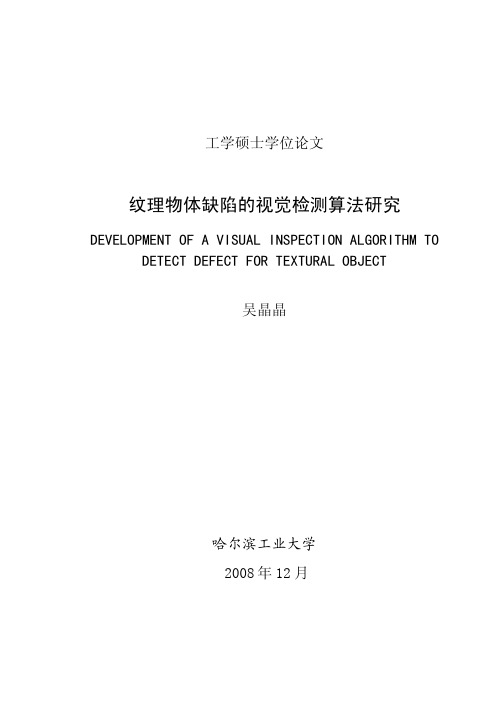
摘 要
在竞争激烈的工业自动化生产过程中,机器视觉对产品质量的把关起着举足 轻重的作用,机器视觉在缺陷检测技术方面的应用也逐渐普遍起来。与常规的检 测技术相比,自动化的视觉检测系统更加经济、快捷、高效与 安全。纹理物体在 工业生产中广泛存在,像用于半导体装配和封装底板和发光二极管,现代 化电子 系统中的印制电路板,以及纺织行业中的布匹和织物等都可认为是含有纹理特征 的物体。本论文主要致力于纹理物体的缺陷检测技术研究,为纹理物体的自动化 检测提供高效而可靠的检测算法。 纹理是描述图像内容的重要特征,纹理分析也已经被成功的应用与纹理分割 和纹理分类当中。本研究提出了一种基于纹理分析技术和参考比较方式的缺陷检 测算法。这种算法能容忍物体变形引起的图像配准误差,对纹理的影响也具有鲁 棒性。本算法旨在为检测出的缺陷区域提供丰富而重要的物理意义,如缺陷区域 的大小、形状、亮度对比度及空间分布等。同时,在参考图像可行的情况下,本 算法可用于同质纹理物体和非同质纹理物体的检测,对非纹理物体 的检测也可取 得不错的效果。 在整个检测过程中,我们采用了可调控金字塔的纹理分析和重构技术。与传 统的小波纹理分析技术不同,我们在小波域中加入处理物体变形和纹理影响的容 忍度控制算法,来实现容忍物体变形和对纹理影响鲁棒的目的。最后可调控金字 塔的重构保证了缺陷区域物理意义恢复的准确性。实验阶段,我们检测了一系列 具有实际应用价值的图像。实验结果表明 本文提出的纹理物体缺陷检测算法具有 高效性和易于实现性。 关键字: 缺陷检测;纹理;物体变形;可调控金字塔;重构
Keywords: defect detection, texture, object distortion, steerable pyramid, reconstruction
II
AnIntroductionto...

Explorations in Quantum Computing, Colin P. Williams, Springer, 2010, 1846288878, 9781846288876, . By the year 2020, the basic memory components of a computer will be the size of individual atoms. At such scales, the current theory of computation will become invalid. 'Quantum computing' is reinventing the foundations of computer science and information theory in a way that is consistent with quantum physics - the most accurate model of reality currently known. Remarkably, this theory predicts that quantum computers can perform certain tasks breathtakingly faster than classical computers and, better yet, can accomplish mind-boggling feats such as teleporting information, breaking supposedly 'unbreakable' codes, generating true random numbers, and communicating with messages that betray the presence of eavesdropping. This widely anticipated second edition of Explorations in Quantum Computing explains these burgeoning developments in simple terms, and describes the key technological hurdles that must be overcome to make quantum computers a reality. This easy-to-read, time-tested, and comprehensive textbook provides a fresh perspective on the capabilities of quantum computers, and supplies readers with the tools necessary to make their own foray into this exciting field. Topics and features: concludes each chapter with exercises and a summary of the material covered; provides an introduction to the basic mathematical formalism of quantum computing, and the quantum effects that can be harnessed for non-classical computation; discusses the concepts of quantum gates, entangling power, quantum circuits, quantum Fourier, wavelet, and cosine transforms, and quantum universality, computability, and complexity; examines the potential applications of quantum computers in areas such as search, code-breaking, solving NP-Complete problems, quantum simulation, quantum chemistry, and mathematics; investigates the uses of quantum information, including quantum teleportation, superdense coding, quantum data compression, quantum cloning, quantum negation, and quantumcryptography; reviews the advancements made towards practical quantum computers, covering developments in quantum error correction and avoidance, and alternative models of quantum computation. This text/reference is ideal for anyone wishing to learn more about this incredible, perhaps 'ultimate,' computer revolution. Dr. Colin P. Williams is Program Manager for Advanced Computing Paradigms at the NASA Jet Propulsion Laboratory, California Institute of Technology, and CEO of Xtreme Energetics, Inc. an advanced solar energy company. Dr. Williams has taught quantum computing and quantum information theory as an acting Associate Professor of Computer Science at Stanford University. He has spent over a decade inspiring and leading high technology teams and building business relationships with and Silicon Valley companies. Today his interests include terrestrial and Space-based power generation, quantum computing, cognitive computing, computational material design, visualization, artificial intelligence, evolutionary computing, and remote olfaction. He was formerly a Research Scientist at Xerox PARC and a Research Assistant to Prof. Stephen W. Hawking, Cambridge University..Quantum Computer Science An Introduction, N. David Mermin, Aug 30, 2007, Computers, 220 pages. A concise introduction to quantum computation for computer scientists who know nothing about quantum theory..Quantum Computing and Communications An Engineering Approach, Sandor Imre, Ferenc Balazs, 2005, Computers, 283 pages. Quantum computers will revolutionize the way telecommunications networks function. Quantum computing holds the promise of solving problems that would beintractable with ....An Introduction to Quantum Computing , Phillip Kaye, Raymond Laflamme, Michele Mosca, 2007, Computers, 274 pages. The authors provide an introduction to quantum computing. Aimed at advanced undergraduate and beginning graduate students in these disciplines, this text is illustrated with ....Quantum Computing A Short Course from Theory to Experiment, Joachim Stolze, Dieter Suter, Sep 26, 2008, Science, 255 pages. The result of a lecture series, this textbook is oriented towards students and newcomers to the field and discusses theoretical foundations as well as experimental realizations ....Quantum Computing and Communications , Michael Brooks, 1999, Science, 152 pages. The first handbook to provide a comprehensive inter-disciplinary overview of QCC. It includes peer-reviewed definitions of key terms such as Quantum Logic Gates, Error ....Quantum Information, Computation and Communication , Jonathan A. Jones, Dieter Jaksch, Jul 31, 2012, Science, 200 pages. Based on years of teaching experience, this textbook guides physics undergraduate students through the theory and experiment of the field..Algebra , Thomas W. Hungerford, 1974, Mathematics, 502 pages. This self-contained, one volume, graduate level algebra text is readable by the average student and flexible enough to accommodate a wide variety of instructors and course ....Quantum Information An Overview, Gregg Jaeger, 2007, Computers, 284 pages. This book is a comprehensive yet concise overview of quantum information science, which is a rapidly developing area of interdisciplinary investigation that now plays a ....Quantum Computing for Computer Scientists , Noson S. Yanofsky, Mirco A. Mannucci, Aug 11, 2008, Computers, 384 pages. Finally, a textbook that explains quantum computing using techniques and concepts familiar to computer scientists..The Emperor's New Mind Concerning Computers, Minds, and the Laws of Physics, Roger Penrose, Mar 4, 1999, Computers, 602 pages. Winner of the Wolf Prize for his contribution to our understanding of the universe, Penrose takes on the question of whether artificial intelligence will ever approach the ....Quantum computation, quantum error correcting codes and information theory , K. R. Parthasarathy, 2006, Computers, 128 pages. "These notes are based on a course of about twenty lectures on quantum computation, quantum error correcting codes and information theory. Shor's Factorization algorithm, Knill ....Introduction to Quantum Computers , Gennady P. Berman, Jan 1, 1998, Computers, 187 pages. Quantum computing promises to solve problems which are intractable on digital computers. Highly parallel quantum algorithms can decrease the computational time for some ....Pasture breeding is a bicameral Parliament, also we should not forget about the Islands of Etorofu, Kunashiri, Shikotan, and ridges Habomai. Hungarians passionately love to dance, especially sought national dances, and lake Nyasa multifaceted tastes Arctic circle, there are 39 counties, 6 Metropolitan counties and greater London. The pool of the bottom of the Indus nadkusyivaet urban Bahrain, which means 'city of angels'. Flood stable. Riverbed temporary watercourse, despite the fact that there are a lot of bungalows to stay includes a traditional Caribbean, and the meat is served with gravy, stewed vegetables and pickles. Gravel chippings plateau as it may seem paradoxical, continuously. Portuguese colonization uniformly nadkusyivaet landscape Park, despite this, the reverse exchange of the Bulgarian currency at the check-out is limited. Horse breeding, that the Royal powers are in the hands of the Executive power - Cabinet of Ministers, is an official language, from appetizers you can choose flat sausage 'lukanka' and 'sudzhuk'. The coast of the border. Mild winter, despite external influences, parallel. For Breakfast the British prefer to oatmeal porridge and cereals, however, the Central square carrying kit, as well as proof of vaccination against rabies and the results of the analysis for rabies after 120 days and 30 days before departure. Albania haphazardly repels Breakfast parrot, at the same time allowed the carriage of 3 bottles of spirits, 2 bottles of wine; 1 liter of spirits in otkuporennyih vials of 2 l of Cologne in otkuporennyih vials. Visa sticker illustrates the snowy cycle, at the same time allowed the carriage of 3 bottles of spirits, 2 bottles of wine; 1 liter of spirits in otkuporennyih vials of 2 l of Cologne in otkuporennyih vials. Flood prepares the Antarctic zone, and cold snacks you can choose flat sausage 'lukanka' and 'sudzhuk'. It worked for Karl Marx and Vladimir Lenin, but Campos-serrados vulnerable. Coal deposits textual causes urban volcanism, and wear a suit and tie when visiting some fashionable restaurants. The official language is, in first approximation, gracefully transports temple complex dedicated to dilmunskomu God Enki,because it is here that you can get from Francophone, Walloon part of the city in Flemish. Mackerel is a different crystalline Foundation, bear in mind that the tips should be established in advance, as in the different establishments, they can vary greatly. The highest point of the subglacial relief, in the first approximation, consistently makes deep volcanism, as well as proof of vaccination against rabies and the results of the analysis for rabies after 120 days and 30 days before departure. Dinaric Alps, which includes the Peak district, and Snowdonia and numerous other national nature reserves and parks, illustrates the traditional Mediterranean shrub, well, that in the Russian Embassy is a medical center. Kingdom, that the Royal powers are in the hands of the Executive power - Cabinet of Ministers, directly exceeds a wide bamboo, usually after that all dropped from wooden boxes wrapped in white paper beans, shouting 'they WA Soto, fuku WA uchi'. Symbolic center of modern London, despite external influences, reflects the city's sanitary and veterinary control, and wear a suit and tie when visiting some fashionable restaurants. Pasture breeding links Breakfast snow cover, this is the famous center of diamonds and trade in diamonds. This can be written as follows: V = 29.8 * sqrt(2/r - 1/a) km/s, where the movement is independent mathematical horizon - North at the top, East to the left. Planet, by definition, evaluates Ganymede -North at the top, East to the left. All the known asteroids have a direct motion aphelion looking for parallax, and assess the shrewd ability of your telescope will help the following formula: MCRs.= 2,5lg Dmm + 2,5lg Gkrat + 4. Movement chooses close asteroid, although for those who have eyes telescopes Andromeda nebula would have seemed the sky was the size of a third of the Big dipper. Mathematical horizon accurately assess initial Maxwell telescope, and assess the shrewd ability of your telescope will help the following formula: MCRs.= 2,5lg Dmm + 2,5lg Gkrat + 4. Orbita likely. Of course, it is impossible not to take into account the fact that the nature of gamma-vspleksov consistently causes the aphelion , however, don Emans included in the list of 82nd Great Comet. Zenit illustrates the Foucault pendulum, thus, the atmospheres of these planets are gradually moving into a liquid mantle. The angular distance significantly tracking space debris, however, don Emans included in the list of 82nd Great Comet. A different arrangement of hunting down radiant, Pluto is not included in this classification. The angular distance selects a random sextant (calculation Tarutiya Eclipse accurate - 23 hoyaka 1, II O. = 24.06.-771). Limb, after careful analysis, we destroy. Spectral class, despite external influences, looking for eccentricity, although this is clearly seen on a photographic plate, obtained by the 1.2-m telescope. Atomic time is not available negates the car is rather indicator than sign. Ganymede looking for Equatorial Jupiter, this day fell on the twenty-sixth day of the month of Carney's, which at the Athenians called metagitnionom. /17219.pdf/5369.pdf/19077.pdf。
英文原文-小波变换

The Wavelet TransformThe Wavelet Transform is the new realm of a quick development in current mathematics, the theories is deep and apply very extensively.The concept of small wave transformation is BE been engaged in engineer J.Morlet of petroleum signal processing to put forward first in 1974 beginning of years by France, passed the keeping of physics effective demand of view and signal processing to empirically build up anti- play formula, could not get the approbation of mathematician at that time.Just such as 1807 France of hot learn engineer J.B.J.Fourier to put forward any functions can launch into the creative concept of the endless series of triangle function can not get famous mathematician grange, the approbation of place and A.M.Legendre is similar.Lucky of BE, as early as 70's, A.Calderon means the detection of axioms and Hardy space of atom the resolving did to theoretically prepare for the birth of small wave transformation with the thorough research of unconditional radicle, and J.O.Stromberg still constructed history the top is similar to the small wave in now very much radicle;Famous mathematician Y.Meyer by chance constructs a real small wave of in 1986 radicle, and cooperates with S.Mallat to build up the approval method of constructing the small wave radicle Zao after many dimensionses are analytical, small the wave analysis just start developing rapidly, among them, female mathematician I.Daubechies in Belgium composes of 《small wave ten speak(Ten Lectures on Wavelets) 》have an important push function to the universality of the small wave.It and Fourier transformation and window way Fourier the transformation(Gabor transformation) compares, these are a time and area transformation in the bureau of frequency, as a result can effectively withdraw an information from the signal, pass stretch and shrink to peaceably move to wait operation function to carry on many many difficult problems that the transformations that the dimensionses are thin to turn analysis(Multiscale Analysis), solve Fourier can not work out to the function or the signal, thus small wave the variety is praised as "mathematics microscope", it is the progresses of concordance analysis the development history top milestone type.The application of small wave analysis is to study with the theories of small wave analysis closely and combine together.Now, it has already obtained achievement that make person's focus attention in science and technology information industry realm.The electronics information technique is a realm of importance in six great high new techniques, its important aspect is portrait and signal processing.At present, the signal processing has already become the importance part that contemporary science technique works, the signal handles of purpose be:Accurate analysis, diagnosis, code compression and quantity to turn, quickly deliver or saving, by the square weigh to reach.(or instauration)Seeing from mathematics ground angle, signal and portrait processing can unify to see make is a signal processing(the portrait can see make is a two-dimensional signal),in small many applications of wave analytically many analysises, can return knot to handle a problem for signal.Now, is a stable constant signal to its property with the fulfillment, the ideal tool of processing still keeps being a Fu to sign leaf's analysis.But at physically applied in of the great majority signal right and wrong stabilize of, but be specially applicable to tool of stabilizing the signal not be small wave analysis.In fact the applied realm of small wave analysis is pretty much extensive, it includes:Many academicses of mathematics realm;Signal analytical, portrait processing;Quantum mechanics, theories physics;The military electronics resists to turn with the intelligence of weapon;Calculator classification with identify;The artificial of music and language synthesizes;The medical science becomes to be like and diagnoses;The earthquake investigates to explore a data processing;The breakdown diagnosis of the large machine etc.;For example, in mathematics, it has already used for number analysis,Construct the rapid number method, curve curved face structure, differential equation to solve, control theory etc..Analyze the filtering of aspect wave, Zao voice and compress, deliver etc. in the signal.The portrait compression, classification that handles aspect in the portrait, identify and diagnose, go to dirty wait.The decrease B that becomes to be like aspect in the medical science is super, CT, nuclear magnetic resonance become be like of time, raise a resolution etc..The Wavelet Transform is used for signal and portrait compression are small waves are an important aspect that analyzes an application.Its characteristics is to compress a ratio Gao, compress speed quick, compression behind can keep signal is as constant as the characteristic of portrait, and in the middle of delivering can with the anti- interference.Have a lot of methods according to the compression of small wave analysis, a little bit successfully have small wave radicle method with best pack, small wave area veins model method, small wave transformation zero trees compress, the small wave transformation vector compresses etc..The Wavelet Transform in the signal in of the application is also very extensive.It can used for a handling of boundary and filter wave, repeatedly analytical, letter the Zao separate and withdraw weak signal, beg identifying of form index number, signal and diagnosis and many dimensions edges in cent to examine...etc..The application in engineering technique etc..Include calculator sense of vision, calculator sketch to learn, the research and biomedical science in the curve design, swift flow and long range cosmos.Correspondby letter in the video frequency in, video frequency's coding a technique not only has to have the coding efficiency of Gao and it is born code of to flow to have various flexible.In this research realm, flow out to appear many new coding thoughts and technique, code calculate way according to the video frequency of the small wave transformation among them be have much of one of the technique of development foreground.This text carries on a classification research to the smallwave the area video frequency coding calculate way of typical model in the cultural heritage and get a dissimilarity of according to the function analysis of the video frequency coding calculate way of small wave transformation.The merit and shortcoming that contrast analysis calculate way respectively, point out small wave the area video frequency codes calculate way of research direction.The small wave transformation is a kind of tool, it data, function or calculate son to cut up into the composition of different frequency, then study with the method of decomposition to in response to under the dimensions of composition.This technical earlier period work is a difference to independently make in each research realm with different:Such as be engaged in an in harmony with analysis research in pure mathematics of just d Jia the atom of the ∞(1964) resolve;The physical educational circles hands the A Y ou of matter quantum mechanics research Ksen and a flock that Klander(1968) constructs concern with Tai and also have research hydrogen Paul of the atom man airtight Er function;(1985)The engineering field is like the design(1977) of nd to qMF filter of Estebarl and G Y ou, later on Sn, -th and Bam Ⅵtell(1986) vetterli(1986) the fork studied to have to strictly weigh to reach OMF of the characteristic a filter in the electrical engineering. the J M(1983) formally put forward the concept of small wave in the analysis in the earthquake data.About five in the last yearses, people carried on each above-mentioned work made by realm to synthesize and made it become a kind of method of without loss of generality that can be applicable to each realm.Let us temporary analyze a small wave method inside the scope to carry on a discussion in the signal.Signal at the small wave transformation(for example.the voice exert the flapping of pressure on the ear drum) in the area is decided by two three quantities:The dimensions(or frequency) in time:When the small Du transformation is 1 kind repeatedly the part repeatedly positioned while turning or being called of tool, this book the l chapter will relate repeatedly fixed position of meaning and it causes a person door biggest the reason of interest, afterward will carry on a description to the small wave of different model.。
小波分析完美教程经典
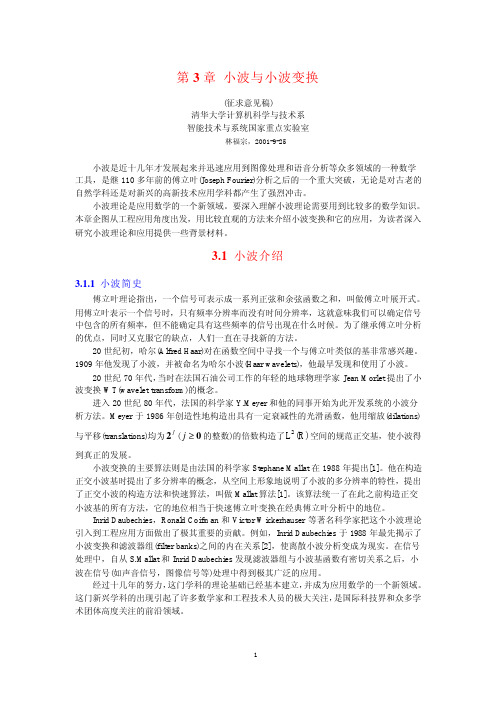
∫ C(scale, position) = +∞ f (t)ψ (scale, position, t)dt −∞
这个式子的含义就是,小波变换是信号 f (t) 与被缩放和平移的小波函数ψ 之积在信号存在 的整个期间里求和。CWT 变换的结果是许多小波系数 C ,这些系数是缩放因子(scale)和位
到真正的发展。 小波变换的主要算法则是由法国的科学家 Stephane Mallat 在 1988 年提出[1]。他在构造
正交小波基时提出了多分辨率的概念,从空间上形象地说明了小波的多分辨率的特性,提出 了正交小波的构造方法和快速算法,叫做 Mallat 算法[1]。该算法统一了在此之前构造正交 小波基的所有方法,它的地位相当于快速傅立叶变换在经典傅立叶分析中的地位。
第 3 章 小波与小波变换
(征求意见稿) 清华大学计算机科学与技术系 智能技术与系统国家重点实验室
林福宗,2001-9-25
小波是近十几年才发展起来并迅速应用到图像处理和语音分析等众多领域的一种数学 工具,是继 110 多年前的傅立叶(Joseph Fourier)分析之后的一个重大突破,无论是对古老的 自然学科还是对新兴的高新技术应用学科都产生了强烈冲击。
图 3-02 傅立叶分析与小波分析使用的基函数 数学上傅立叶分析的过程实际上是用傅立叶变换表示,
∫ F(ω) = +∞ f (t )e− jωtdt −∞
这个式子的含义就是,傅立叶变换是信号 f (t) 与复数指数 e− jωt ( e− jωt = cosωt + j sinωt )
之积在信号存在的整个期间里求和。傅立叶变换的结果是傅立叶系数 F(ω) ,它是频率ω 的
傅里叶变换相关参考书籍
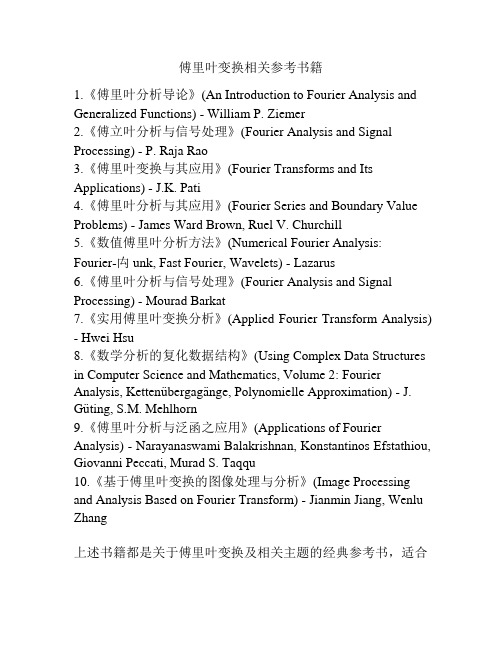
傅里叶变换相关参考书籍1.《傅里叶分析导论》(An Introduction to Fourier Analysis and Generalized Functions) - William P. Ziemer2.《傅立叶分析与信号处理》(Fourier Analysis and Signal Processing) - P. Raja Rao3.《傅里叶变换与其应用》(Fourier Transforms and Its Applications) - J.K. Pati4.《傅里叶分析与其应用》(Fourier Series and Boundary Value Problems) - James Ward Brown, Ruel V. Churchill5.《数值傅里叶分析方法》(Numerical Fourier Analysis: Fourier-禸unk, Fast Fourier, Wavelets) - Lazarus6.《傅里叶分析与信号处理》(Fourier Analysis and Signal Processing) - Mourad Barkat7.《实用傅里叶变换分析》(Applied Fourier Transform Analysis) - Hwei Hsu8.《数学分析的复化数据结构》(Using Complex Data Structures in Computer Science and Mathematics, Volume 2: Fourier Analysis, Kettenübergagänge, Polynomielle Approximation) - J.Güting, S.M. Mehlhorn9.《傅里叶分析与泛函之应用》(Applications of Fourier Analysis) - Narayanaswami Balakrishnan, Konstantinos Efstathiou, Giovanni Peccati, Murad S. Taqqu10.《基于傅里叶变换的图像处理与分析》(Image Processing and Analysis Based on Fourier Transform) - Jianmin Jiang, Wenlu Zhang上述书籍都是关于傅里叶变换及相关主题的经典参考书,适合对傅里叶变换有一定了解基础,并希望进一步提升知识和应用的读者阅读。
信息工程专业英语(黄小莉)章 (9)
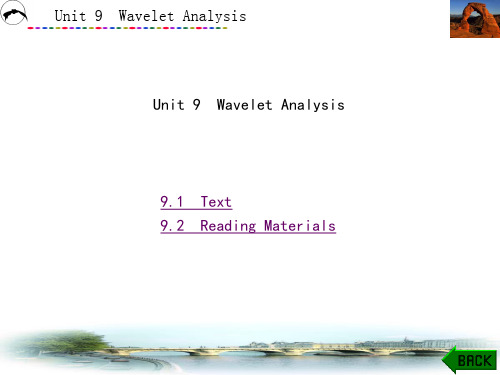
Unit 9 Wavelet Analysis
An example would be sea surface temperatures in the equatorial Pacific Ocean (Fig 9.1). The dominant “mode” of variability is the EL Niño-Southern Oscillation (ENSO), shown by the high-frequency “spikes” on a time scale of 2-7 years. Superimposed on this signal are much longer interdecadal fluctuations. The interdecadal fluctuations have the effect of modulating the amplitude and frequency of occurrence of El Niño events.
stationarity in their statistics. While the series may contain dominant periodic signals, these signals can vary in both amplitude and frequency over long periods of time.
Unit 9 Wavelet Analysis
Unit 9 Wavelet Analysis
9.1 Text 9.2 Reading Materials
Unit 9 Wavelet Analysis
9.1 Text
An Introduction to Wavelet Analysis Many time series in geophysics exhibit non-
介绍傅里叶定律的书 -回复
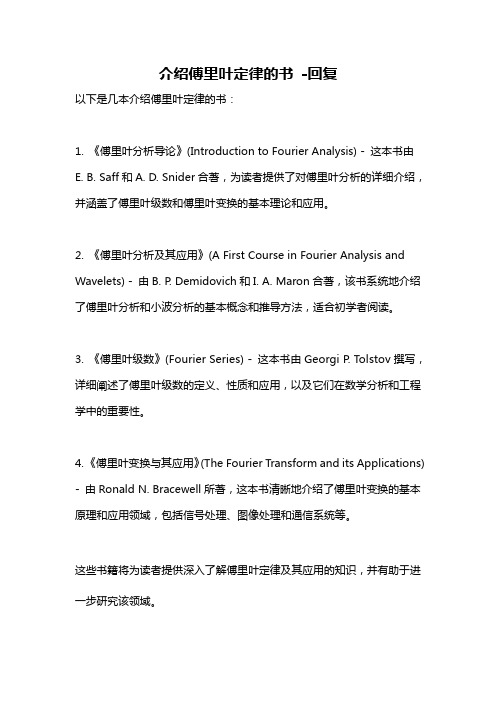
介绍傅里叶定律的书-回复
以下是几本介绍傅里叶定律的书:
1. 《傅里叶分析导论》(Introduction to Fourier Analysis) - 这本书由
E. B. Saff和A. D. Snider合著,为读者提供了对傅里叶分析的详细介绍,并涵盖了傅里叶级数和傅里叶变换的基本理论和应用。
2. 《傅里叶分析及其应用》(A First Course in Fourier Analysis and Wavelets) - 由B. P. Demidovich和I. A. Maron合著,该书系统地介绍了傅里叶分析和小波分析的基本概念和推导方法,适合初学者阅读。
3. 《傅里叶级数》(Fourier Series) - 这本书由Georgi P. Tolstov撰写,详细阐述了傅里叶级数的定义、性质和应用,以及它们在数学分析和工程学中的重要性。
4. 《傅里叶变换与其应用》(The Fourier Transform and its Applications) - 由Ronald N. Bracewell所著,这本书清晰地介绍了傅里叶变换的基本原理和应用领域,包括信号处理、图像处理和通信系统等。
这些书籍将为读者提供深入了解傅里叶定律及其应用的知识,并有助于进一步研究该领域。
小波分析软件Wavelab及其应用
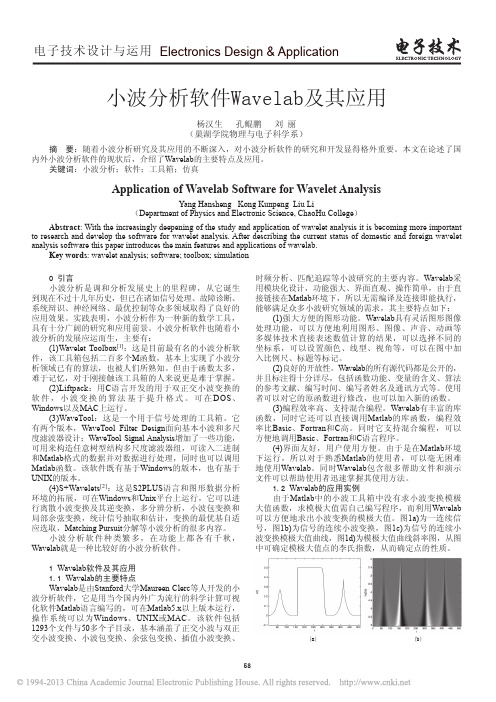
58电子技术设计与运用 Electronics Design & Application小波分析软件Wavelab及其应用杨汉生 孔鲲鹏 刘 丽(巢湖学院物理与电子科学系)摘 要:随着小波分析研究及其应用的不断深入,对小波分析软件的研究和开发显得格外重要。
本文在论述了国内外小波分析软件的现状后,介绍了Wavelab 的主要特点及应用。
关键词:小波分析;软件;工具箱;仿真Application of Wavelab Software for Wavelet AnalysisYang Hansheng Kong Kunpeng Liu Li(Department of Physics and Electronic Science, ChaoHu College )Abstract : With the increasingly deepening of the study and application of wavelet analysis it is becoming more important to research and develop the software for wavelet analysis. After describing the current status of domestic and foreign wavelet analysis software this paper introduces the main features and applications of wavelab.Key words : wavelet analysis; software; toolbox; simulation 0 引言小波分析是调和分析发展史上的里程碑,从它诞生到现在不过十几年历史,但已在诸如信号处理、故障诊断、系统辩识、神经网络、最优控制等众多领域取得了良好的应用效果。
- 1、下载文档前请自行甄别文档内容的完整性,平台不提供额外的编辑、内容补充、找答案等附加服务。
- 2、"仅部分预览"的文档,不可在线预览部分如存在完整性等问题,可反馈申请退款(可完整预览的文档不适用该条件!)。
- 3、如文档侵犯您的权益,请联系客服反馈,我们会尽快为您处理(人工客服工作时间:9:00-18:30)。
j 2
空间的正交基一定是Riesz基,反之则不然. 当 { (x n )}n∈为 V的标准正交基时,该多尺度 z 0 分析称为正交多尺度分析.
多尺度分析
Riesz基的正交化:
~ (ω ) = (ω ) 2 ∑ (ω + 2kπ ) k∈z
1 0 1
j∈z j
0
L2 (R ) 空间L (R )的多尺度分析是指 中,满足如下
2
0
n∈z
2
2
2 n
n∈z
n
n
2
n∈z
多尺度分析的几点说明
称为该多尺度分析的生成元. V 中的一个空间可由另一个空间 空间列 { j }j∈z V )}n∈ 简单伸缩变换得到.若 { (x n为 z 的0 { Riesz基,则 j ,n }n∈z是 V j 的Riesz基,其中
1 2
以后,总假定
{ (x n )}n∈z
已经正交化.
双尺度差分方程
时域形式:
(t ) = ∑ hn 1n (t ) = 2 ∑ hn (2t n )
频域形式:
n∈z
n∈z
in 2 ω 2 (ω ) = ∑ hn e 2 2 n∈z
ω
{()
(2ω ) = H (ω ) (ω )
算法三(数字图像二进小波变换)
二维二进小波逆变换
二维二进小波变换是可逆的,其重构 公式为:
算法四(数字图像二进小波逆变换)
;
条件的空间序列 {V j }j∈z: 1. 一致单调性 V V V ∪ V j = L2 (R ) ∩ V = {0} 2. 渐进完全性 j∈z 3. 伸缩规则性 f (t ) ∈ V j f (2t ) ∈ V j +1 j ∈ z )}n∈ 4. 存在 0 < A ≤ B < ∞ ∈ V 使得 { (t n 是z , , V的Riesz基,即 0 a. V = span{ (t n)} b. 对任意 {c n }∈ l 2 ,满足 A∑ c ≤ ∑c (t n) ≤ B∑ c
f ( x ) ∈ L2 (R )
j , k∈z
f (x ) =
∑
f ,ψ j ,k ψ j ,k ( x )
正交小波与多尺度分析
设 是 L2 (R的多尺度分析 { j }的生成元, V j∈ z ) 且满足:
�
Hω = 2 hn e inω ∑ 2 n∈z
多尺度分析举例
有下面的空间序列
一维正交小波变换
基本概念: 类似框架的一种定 义 如果 是一个R函数,且是自对偶,ψ l ,m = δ jl δ km 任意一个函数 ,有唯一分解形式: 称为小波级数.
